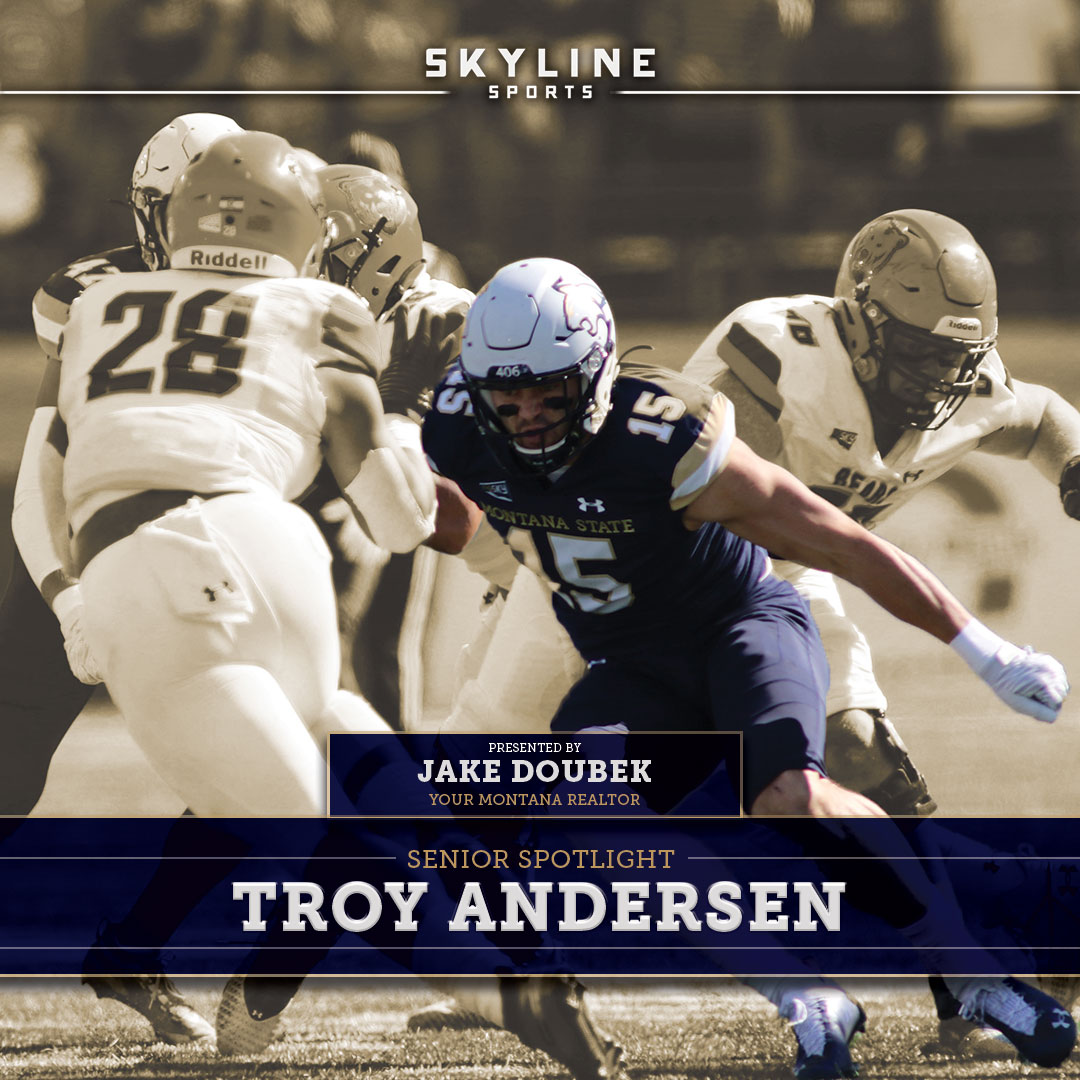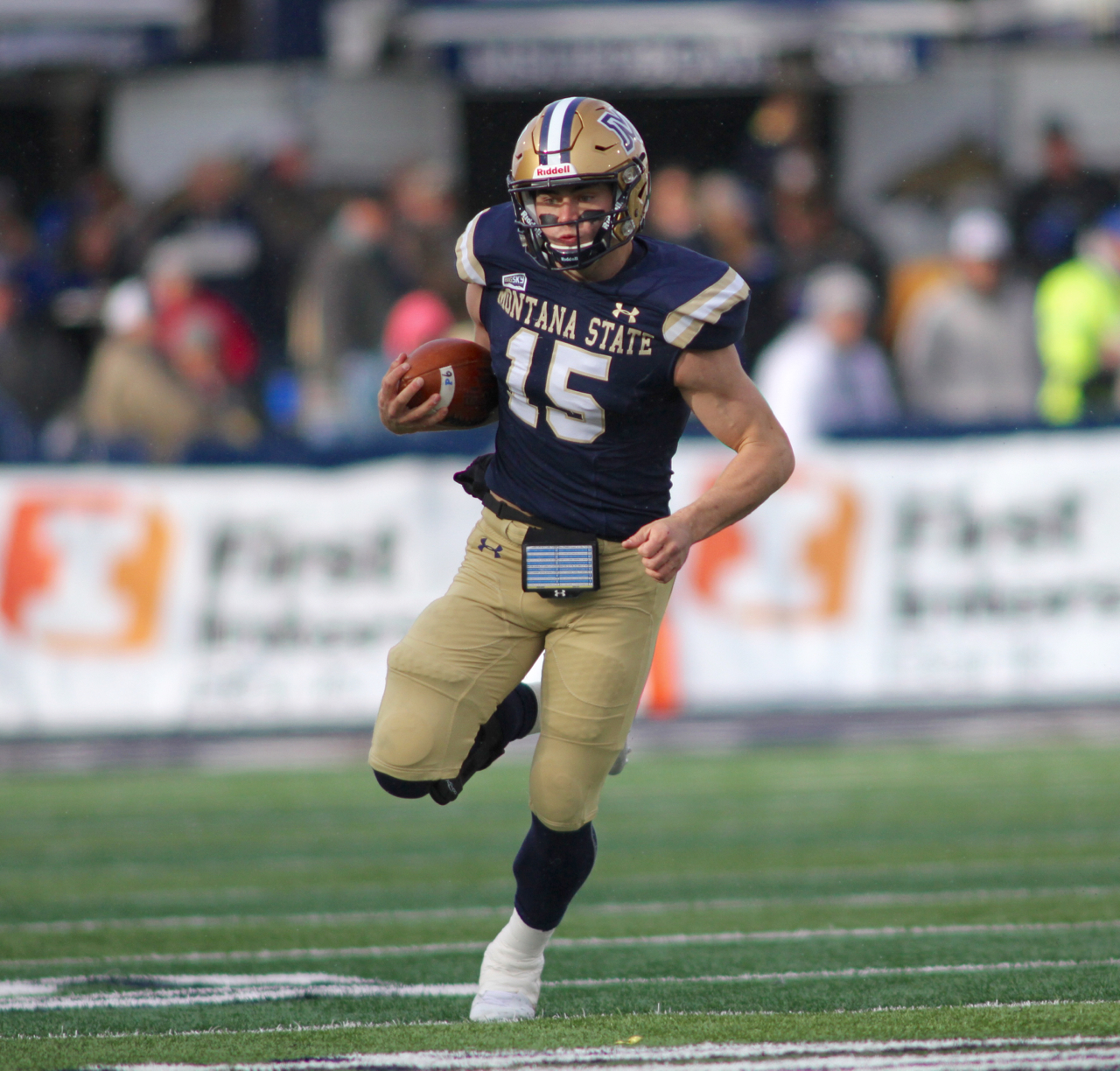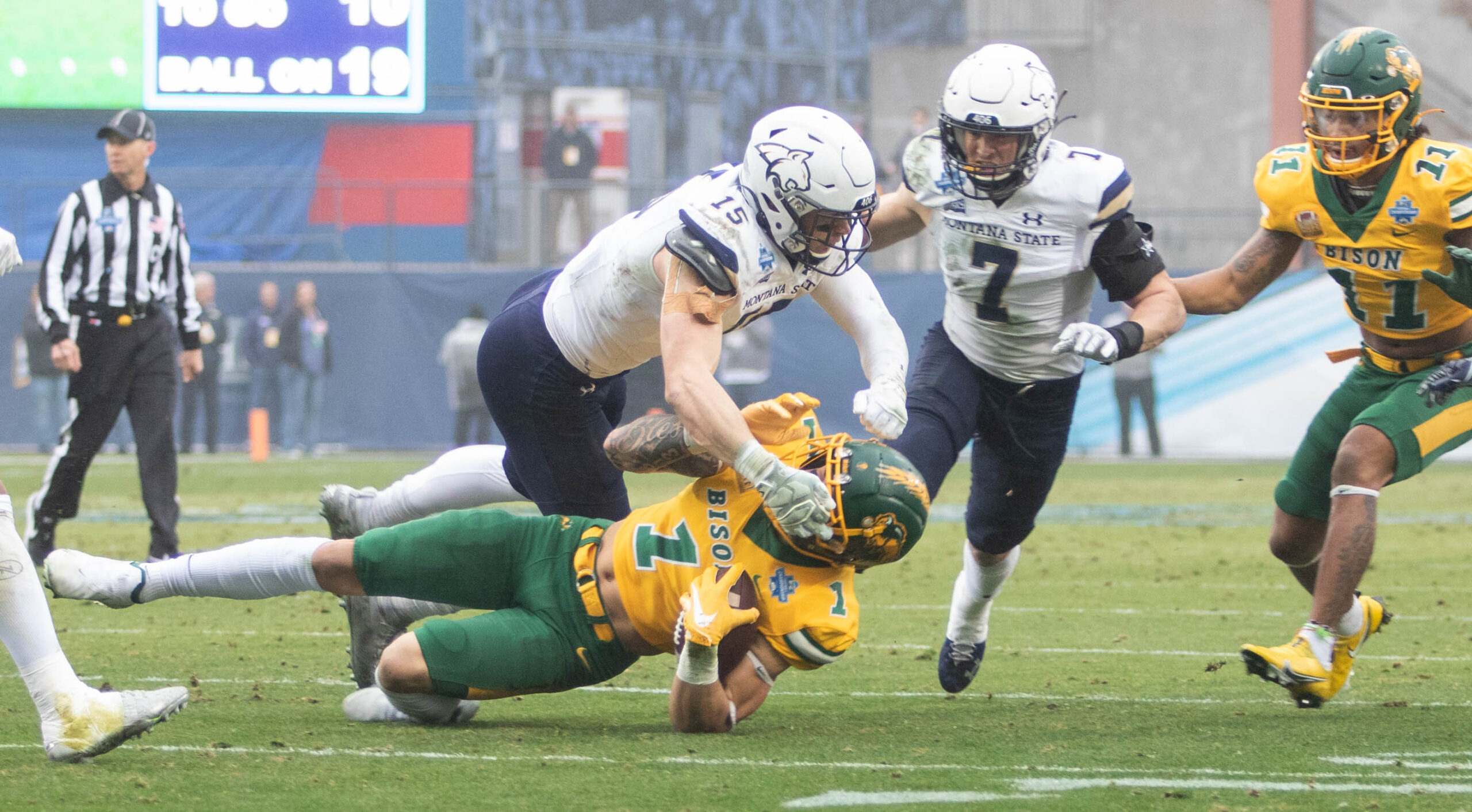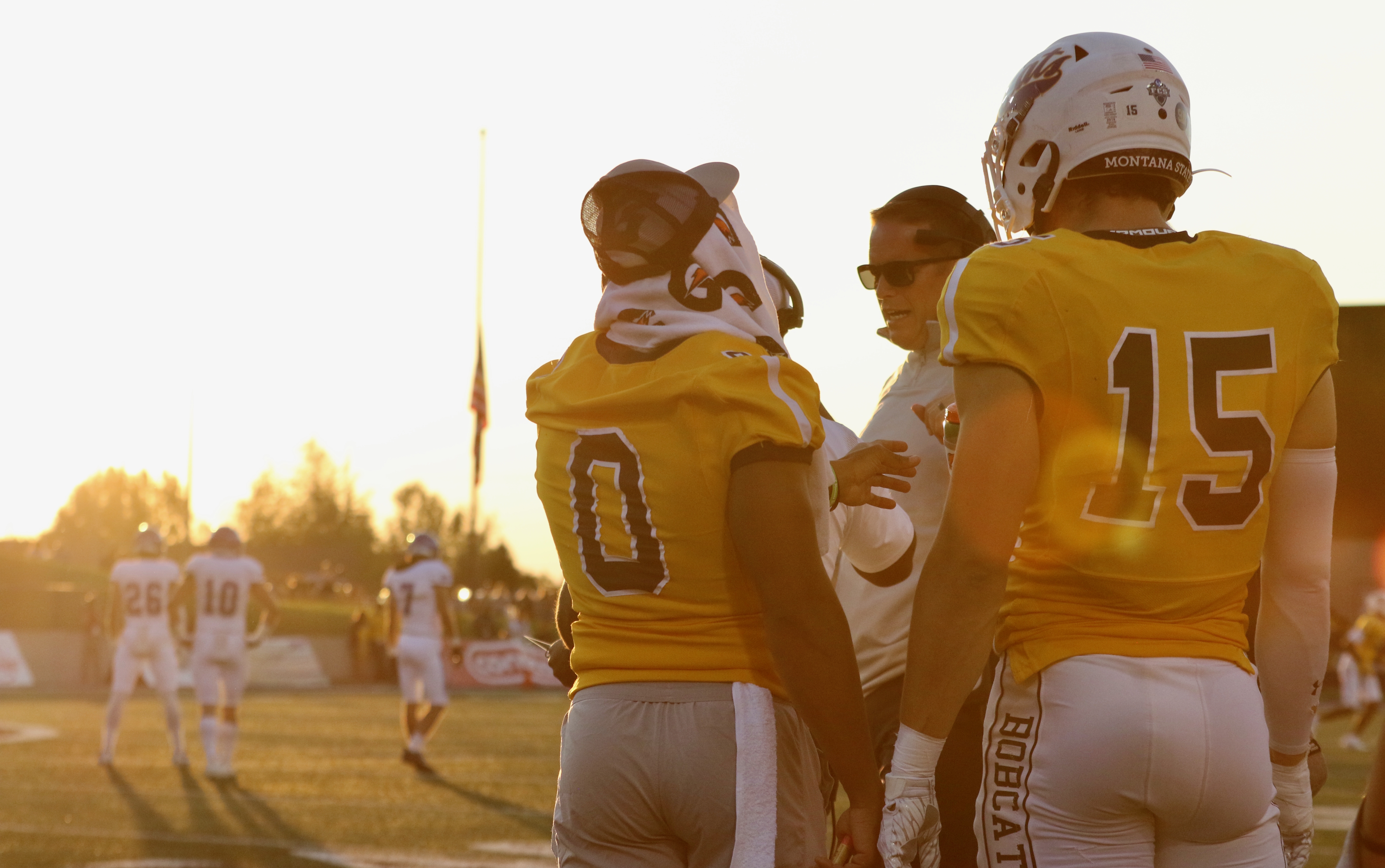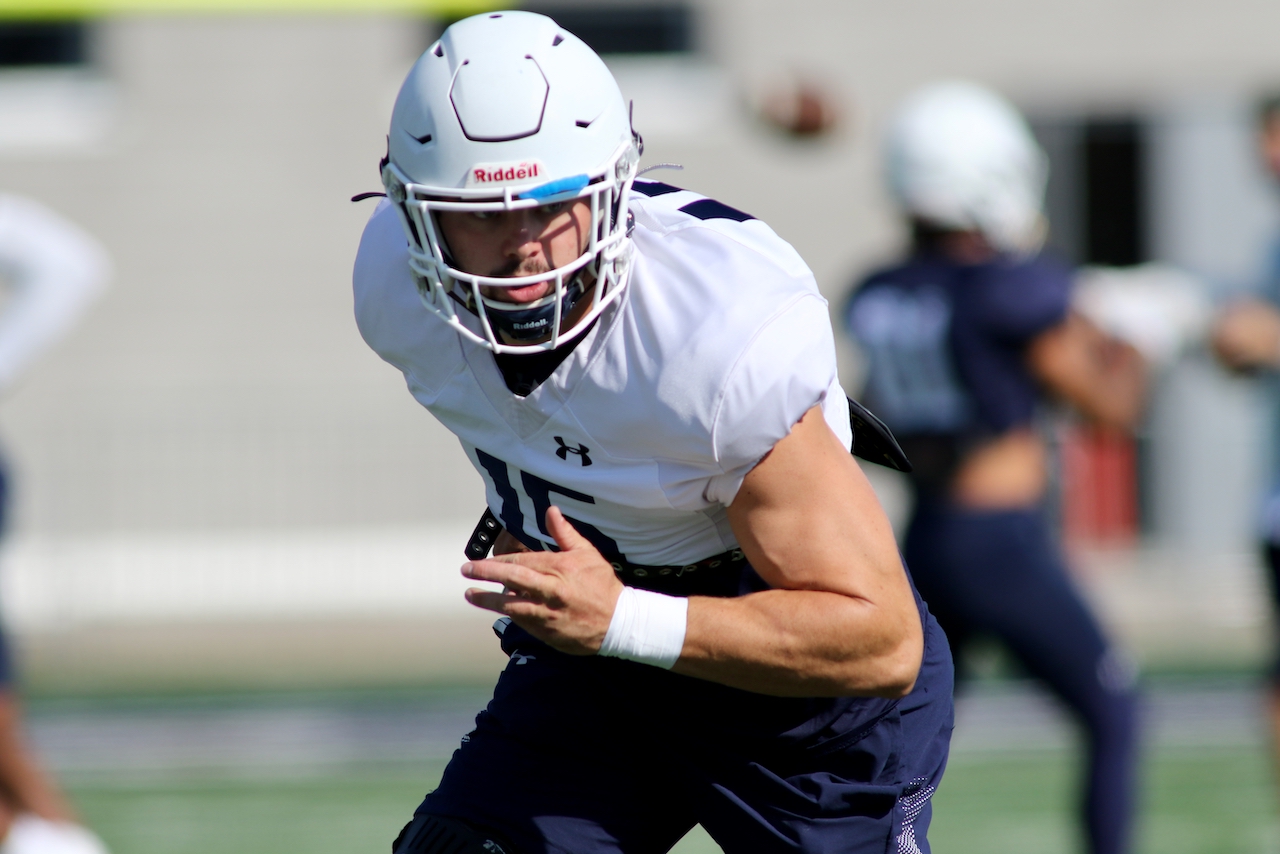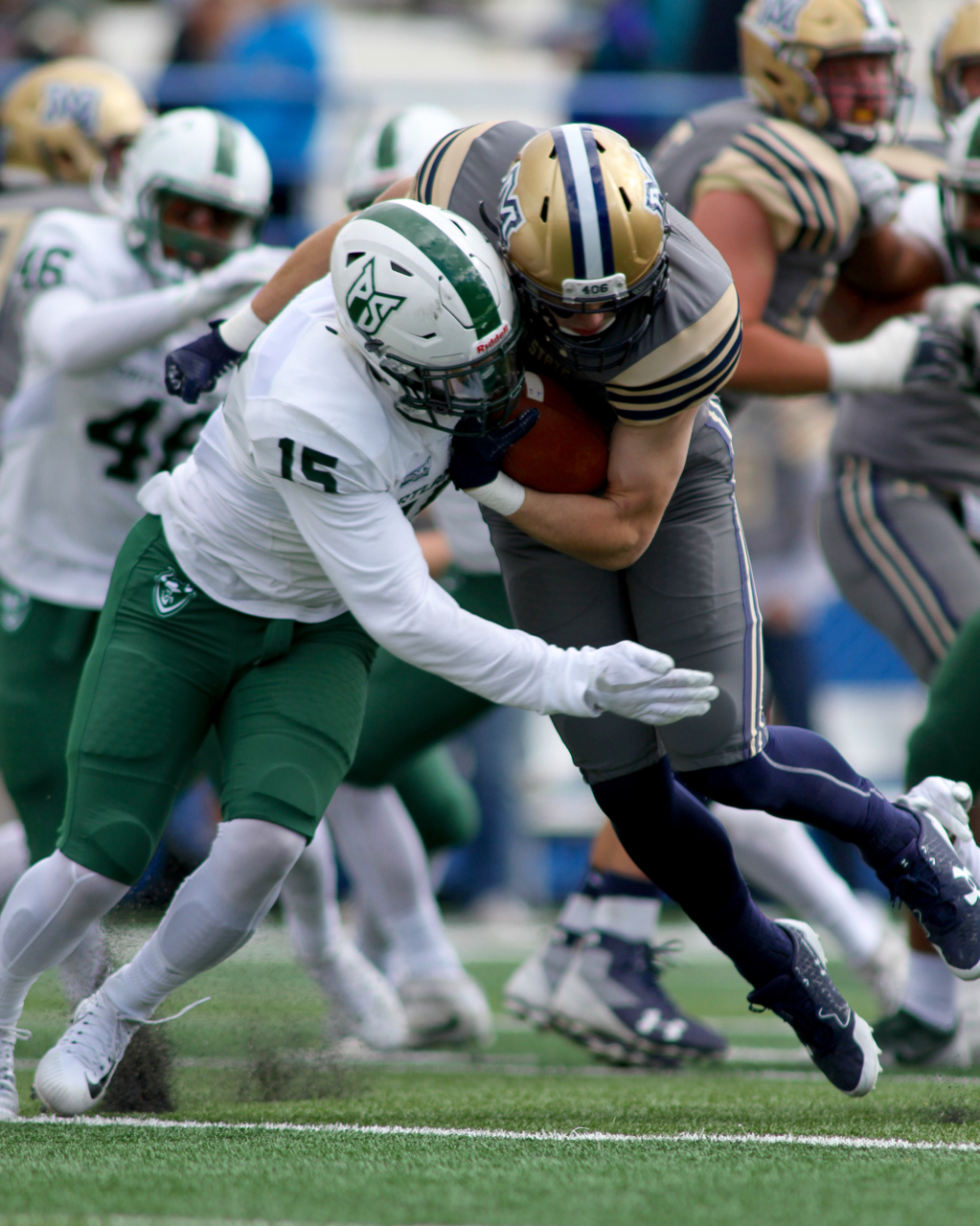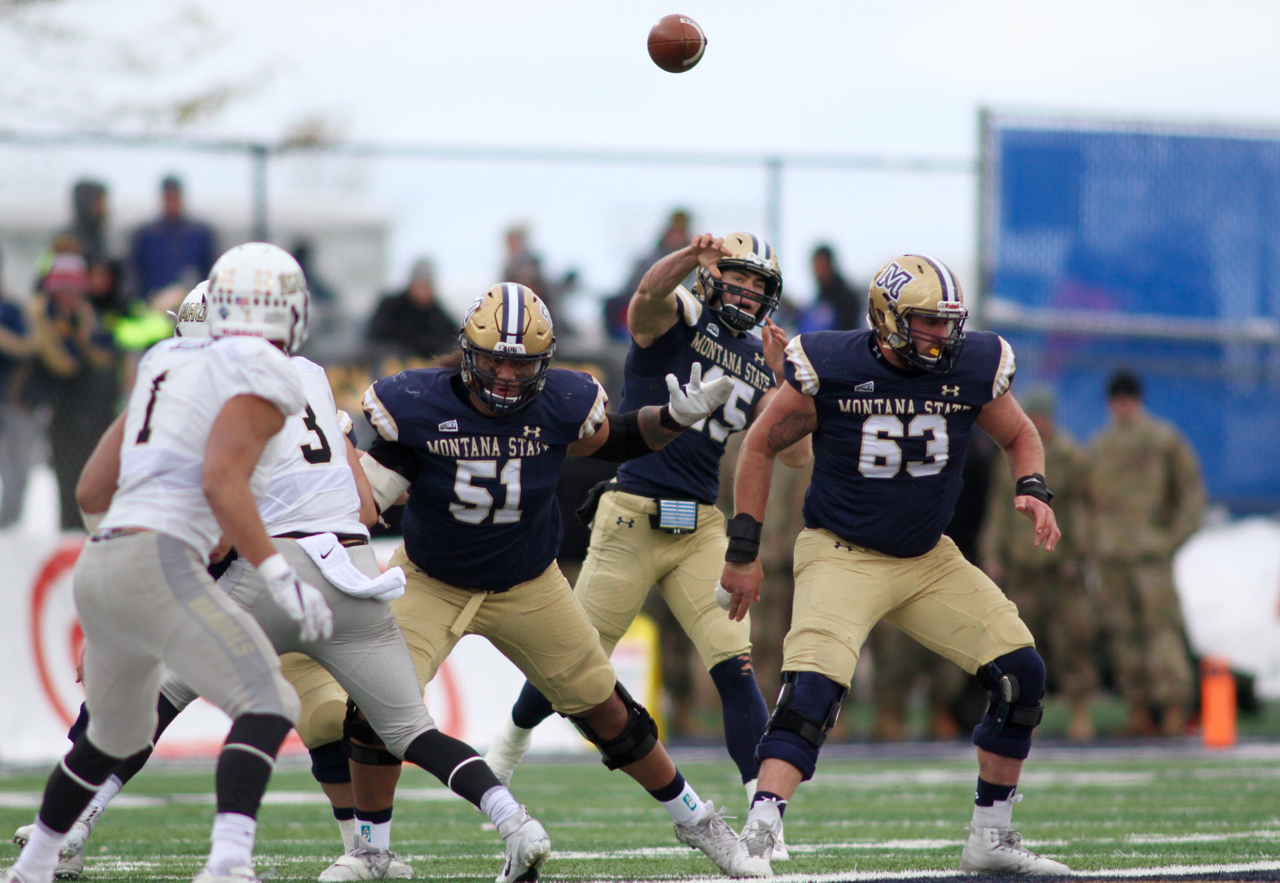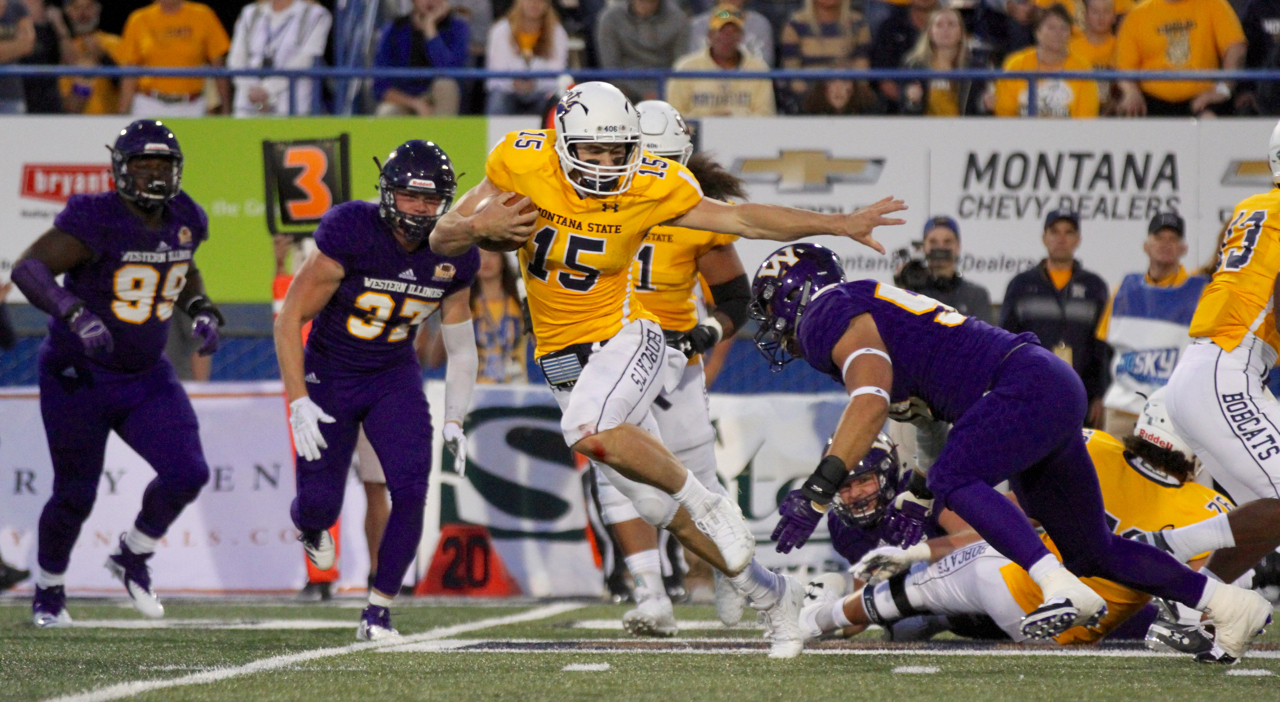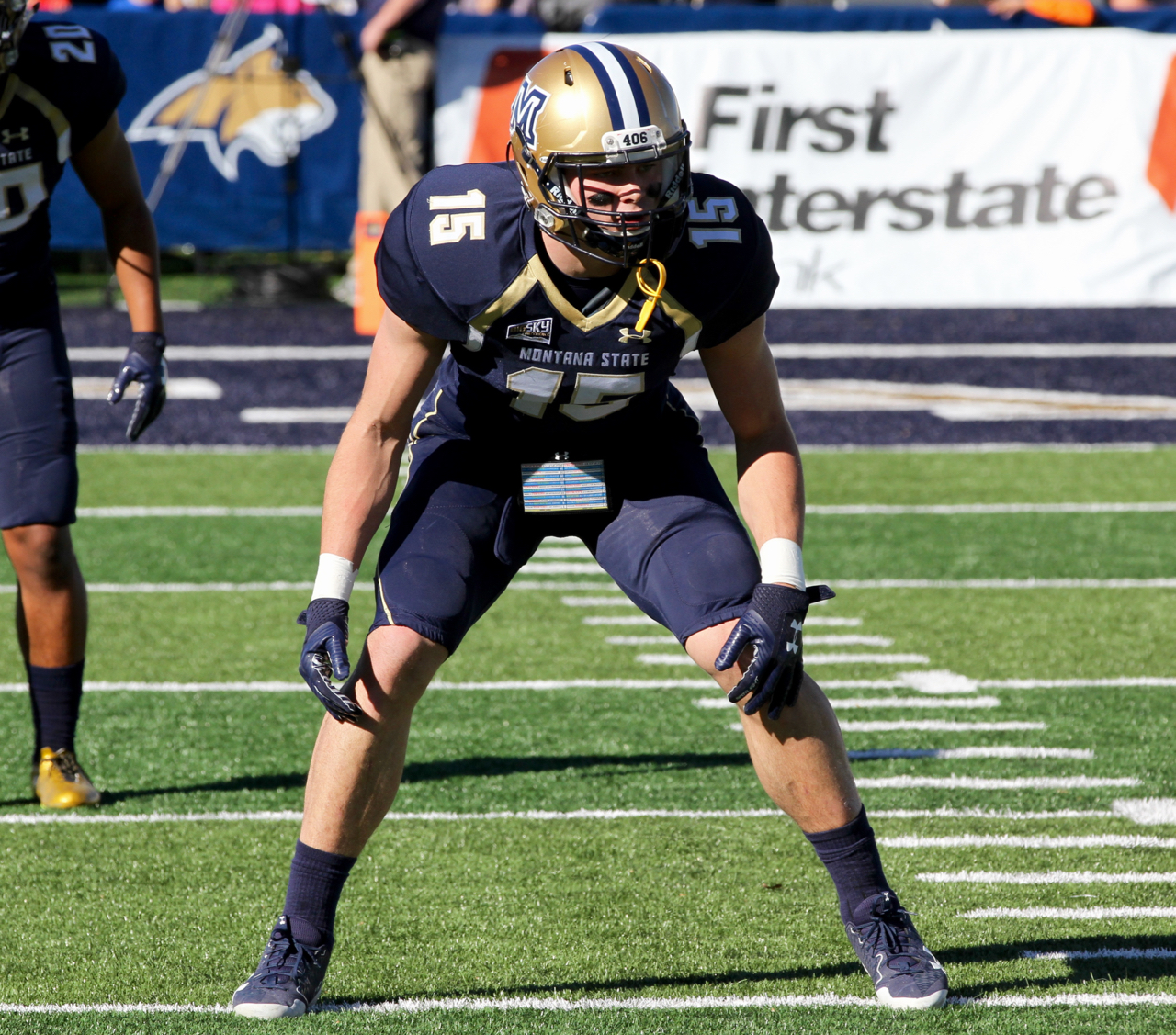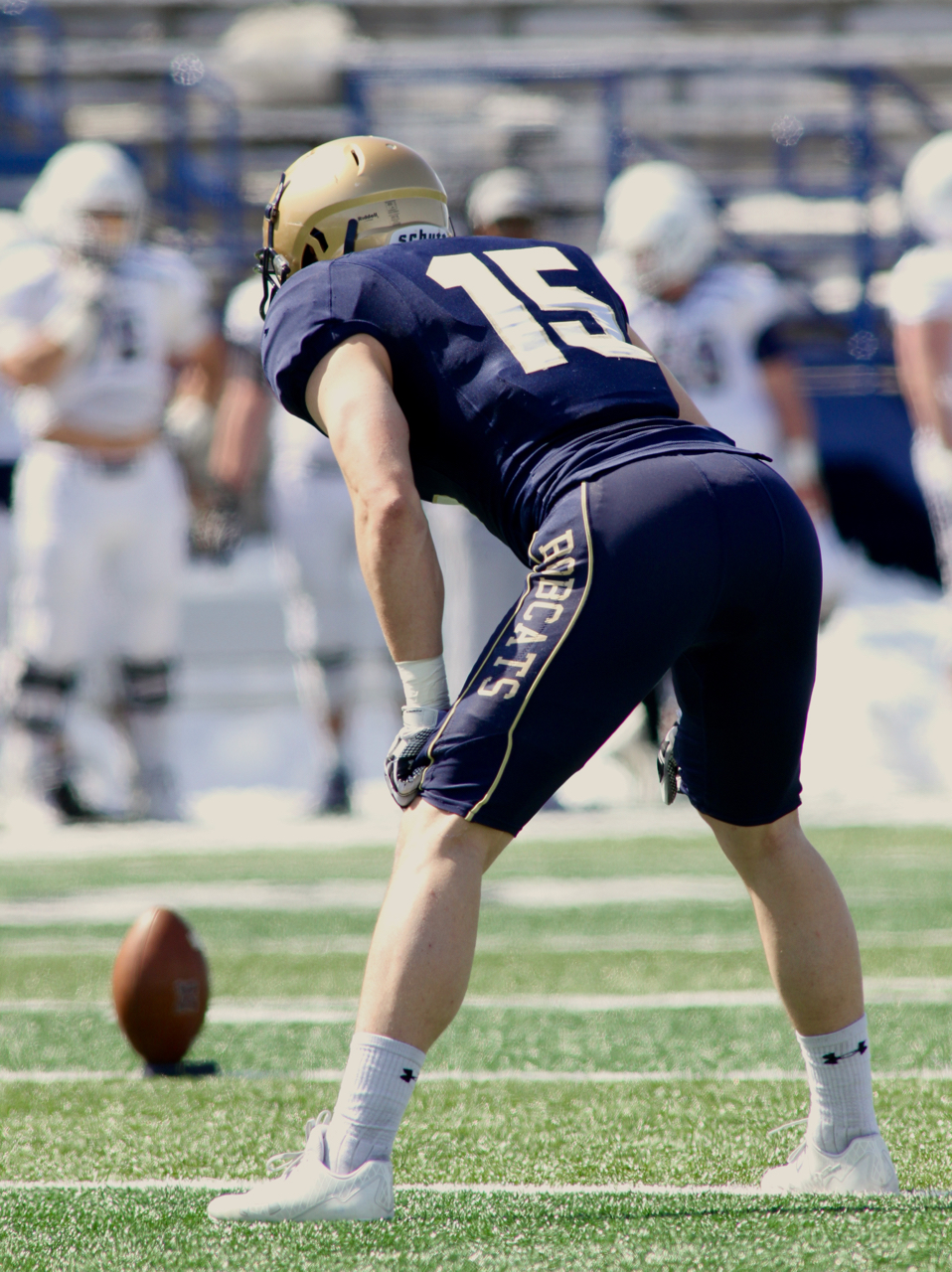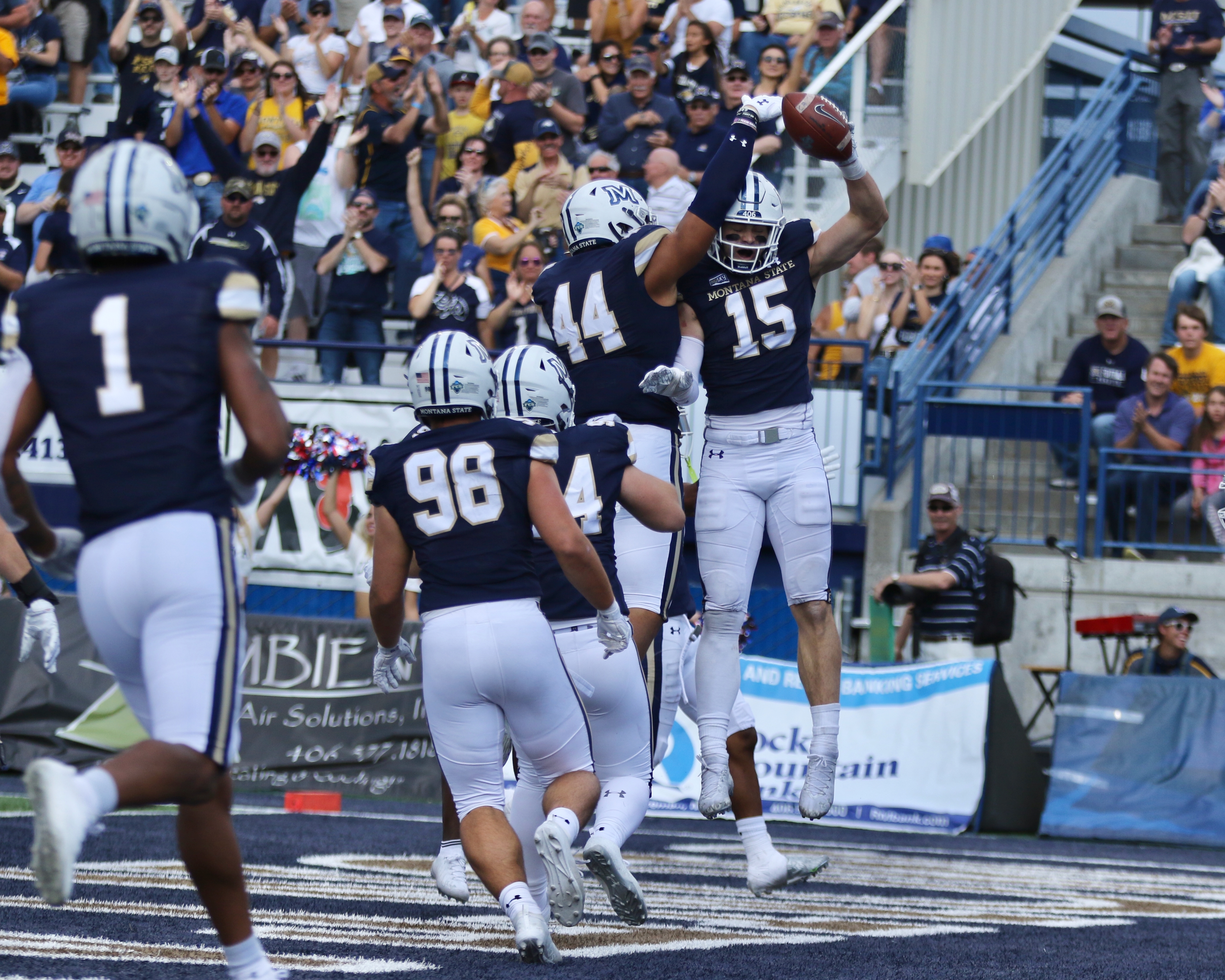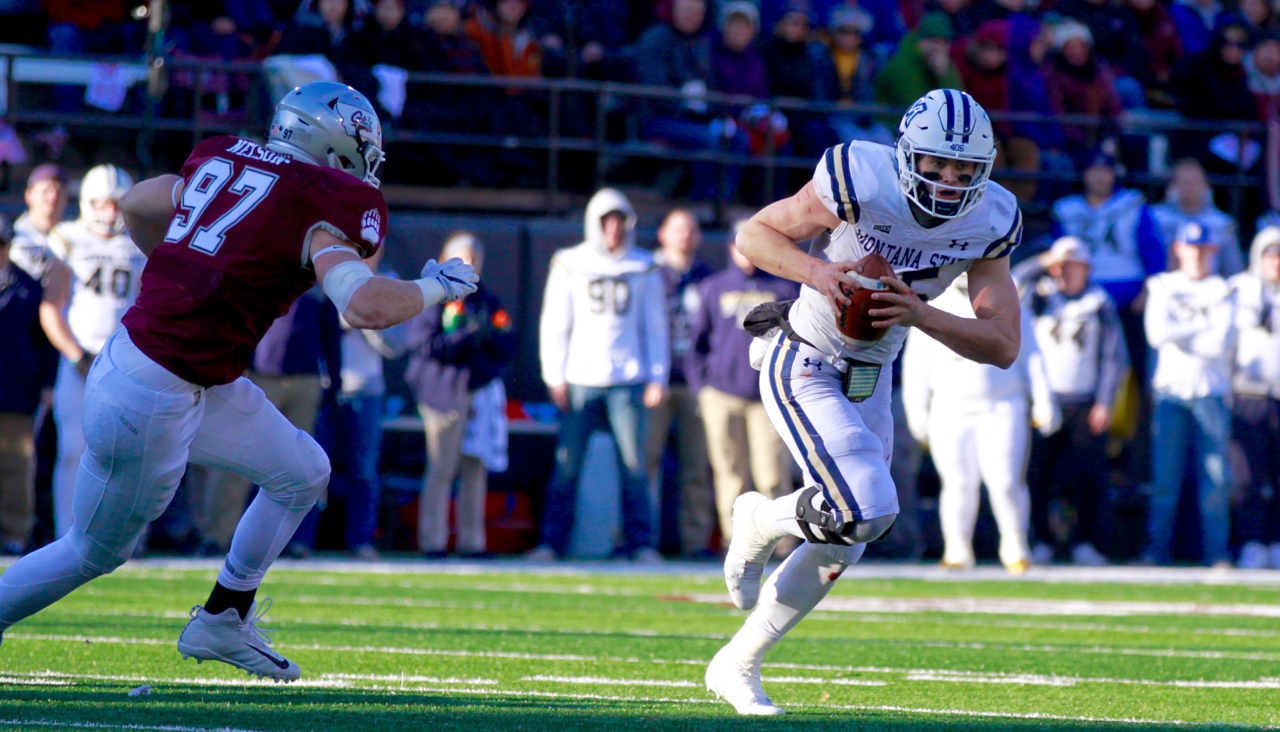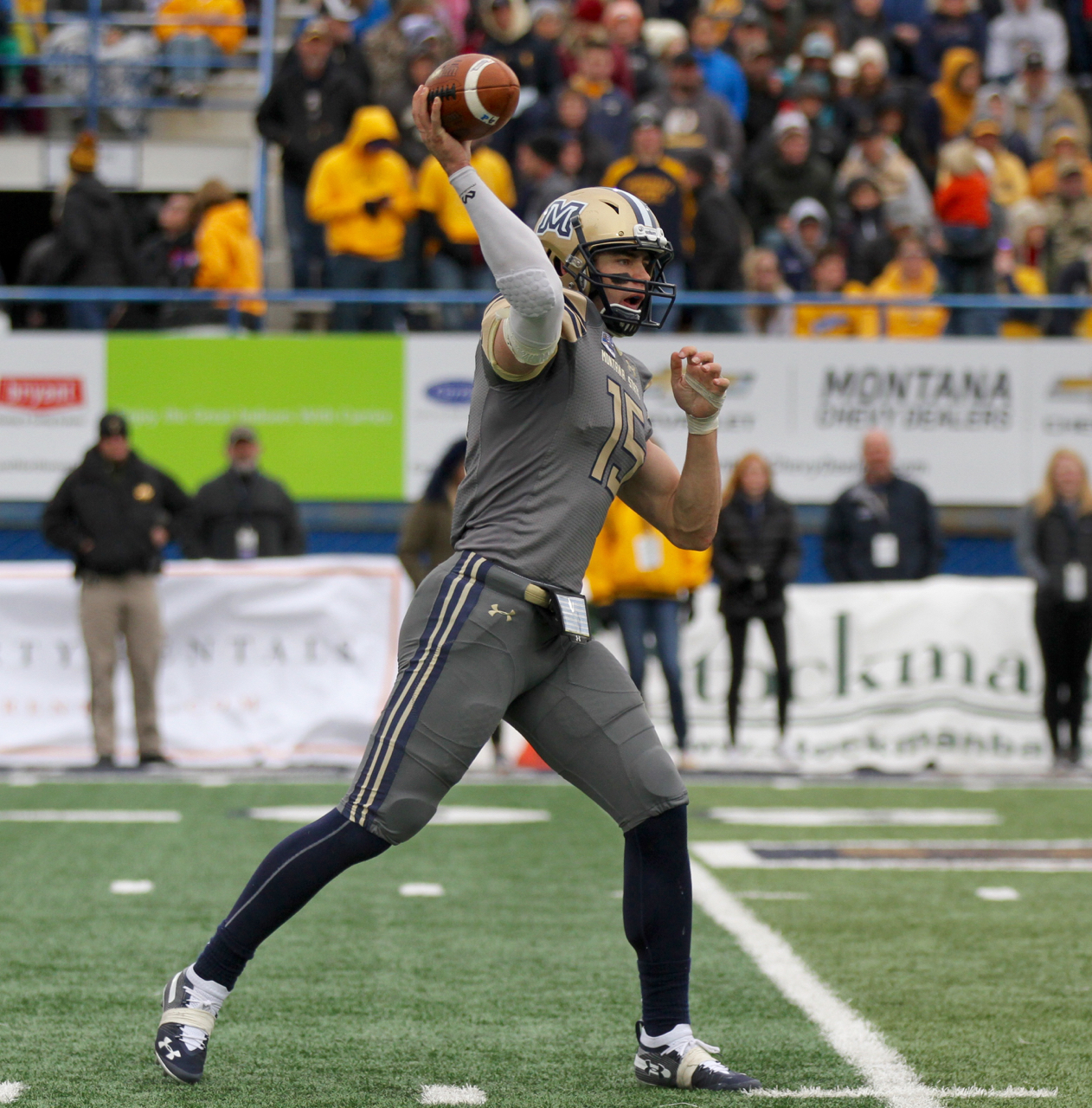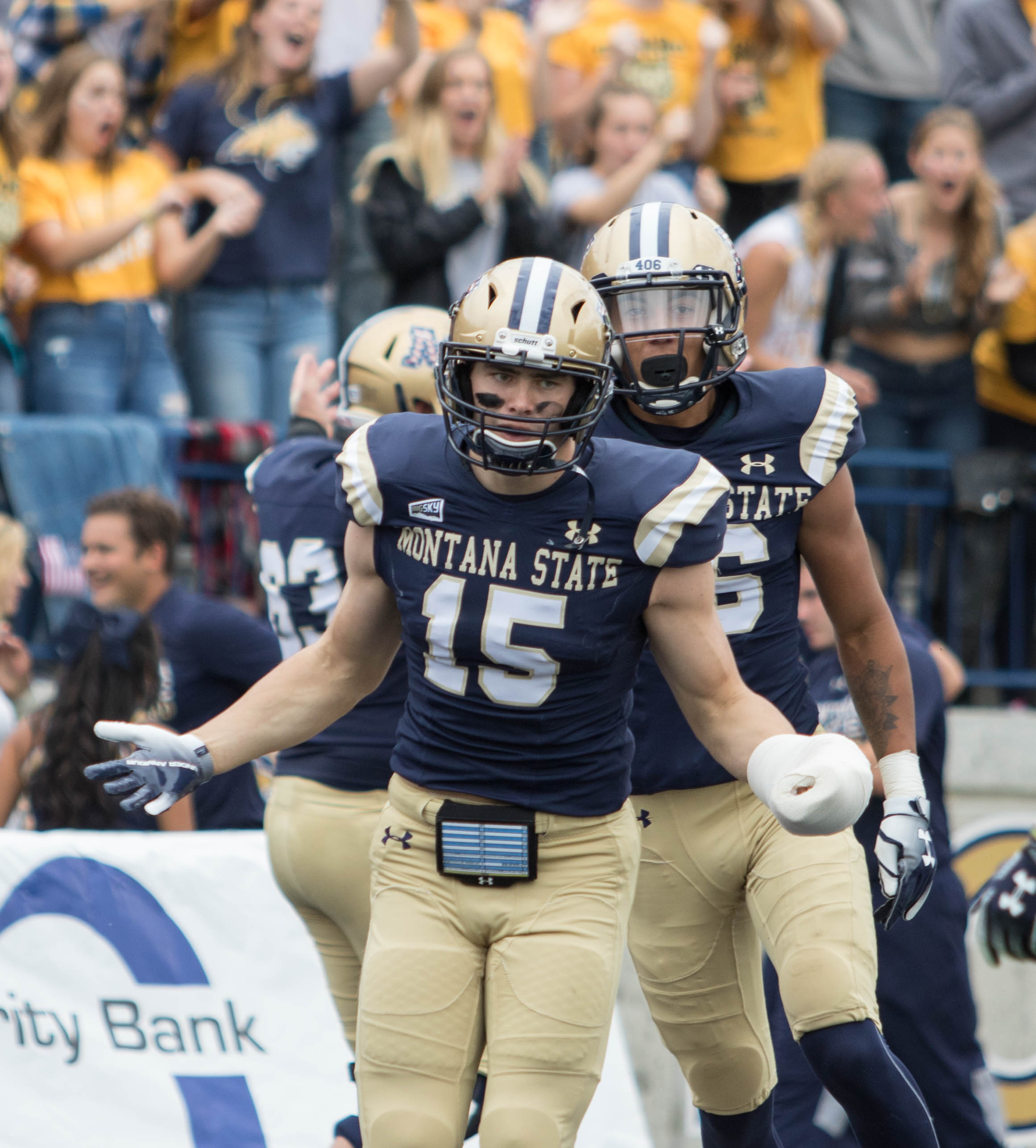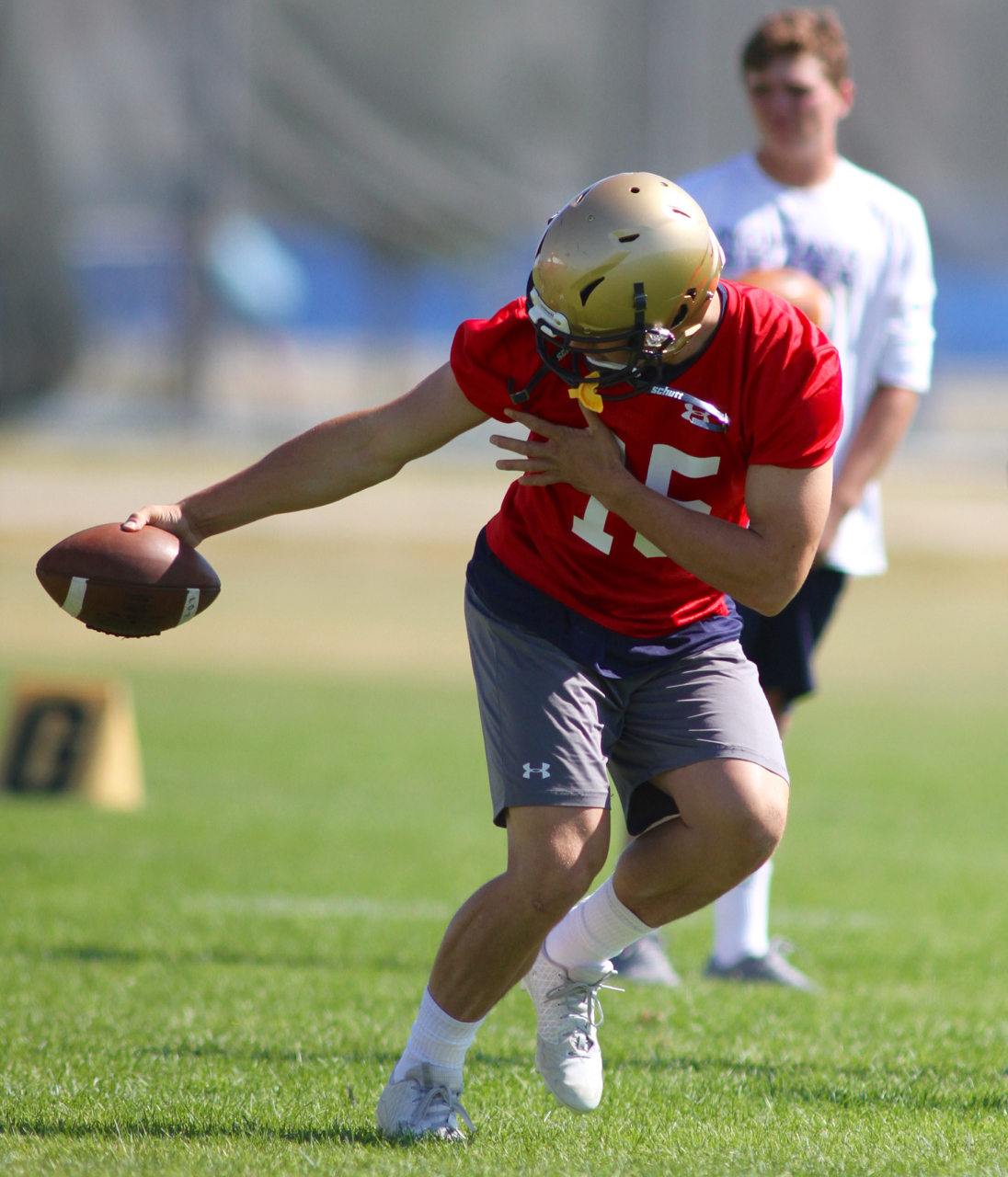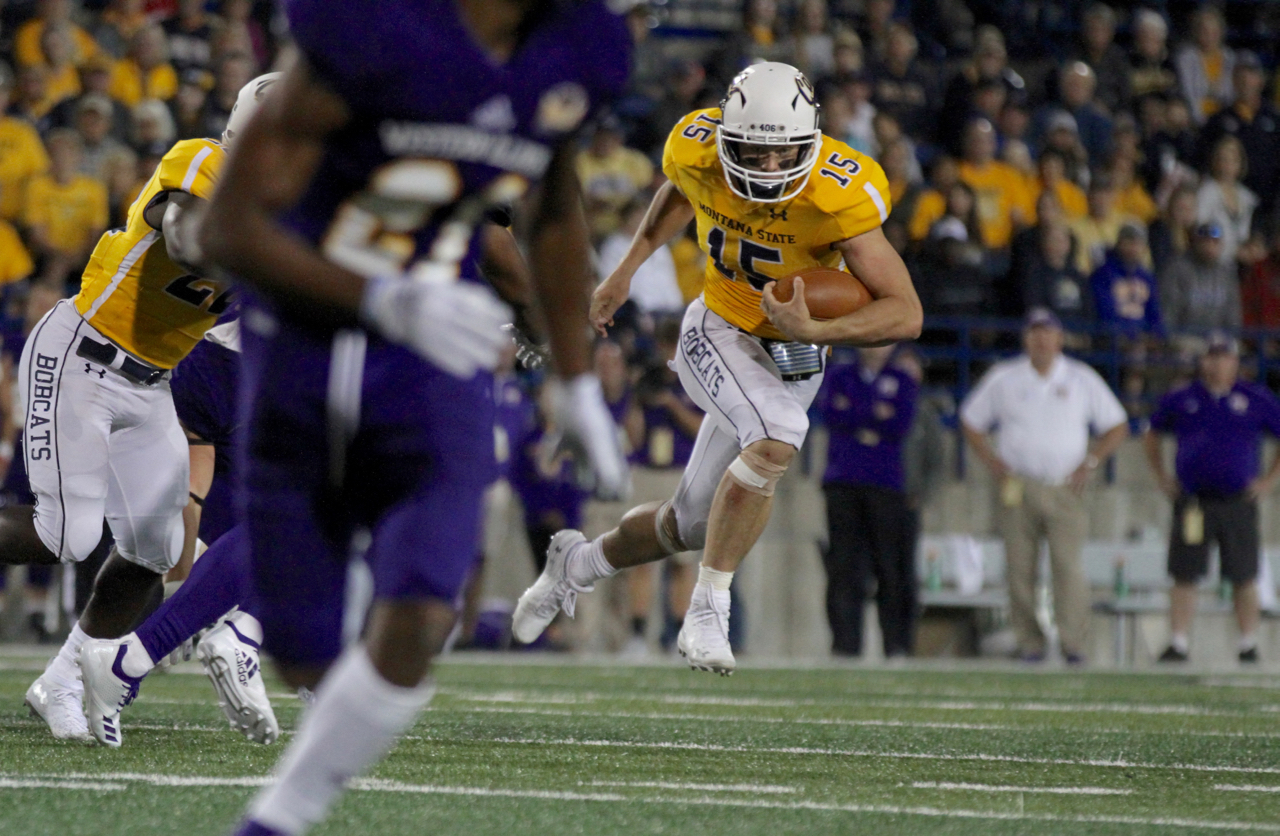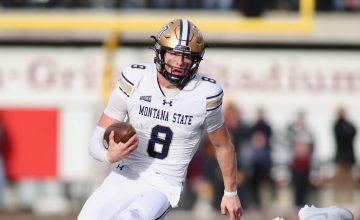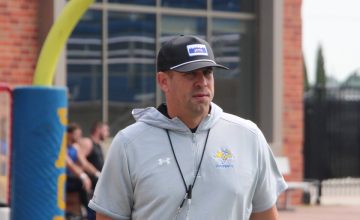Paul Bunyan is not only an All-American myth but as far as can be determined, the only myth or legend in this country. It is all-American because Paul’s exploits are all accomplished on this continent and there is no counterpart in the Old World. The origin of Paul is as much a myth as the legend itself.
The myth that is Troy Andersen began echoing across Southwestern Montana and throughout the Treasure State well before the rest of the country discovered anything about the modern-day folk hero.
The myth began as a whisper as he spent early years on a ranch near the Jackson River helping his parents keep track of 800 head of cattle. Andersen was big and strong from a young age. By the time he entered elementary school, longtime Dillon head football coach Rick Nordahl — who’s youngest son Todd has been one of Andersen’s best friends since kindergarten — thought to himself, “This kid has a chance to be the best to ever come out of this town.”
After fortifying himself as an all-time high school great in his tradition-rich hometown, Andersen’s commitment to Montana State after one of the briefest recruiting pushes of the modern era, helping new head coach Jeff Choate announce his presence on the Treasure State stage. Andersen’s pledge to MSU helped put an exclamation on Choate’s ambitious proclamation that the Bobcats would “Beat the Sky, Own the State.”
When he committed to Montana State, the first member of the 2017 recruiting class, Andersen said he wanted his choice to boost MSU’s momentum in the greatest rivalry in the West against the enemy Griz of Montana.
As a senior at Beaverhead County High School, Andersen won state championships in football, basketball and track following his commitment. A parade of some of Montana’s best prep football players indeed did follow Andersen to Montana State over the next several years. Beating the Grizzlies four years in a row certainly didn’t hurt Choate’s recruiting pitch to Montanans, either. Yet he could not have done it without the figurehead, the face of the program, the poster boy and rallying cry.
On National Signing Day in February of 2017 before Andersen had helped guide Dillon to a state basketball championship, before he had swept the 100 and 200 meters at the state track meet for the second year in a row, Choate compared Andersen to Matt Miller, a former Montana Gatorade Player of the Year in football and a hurdles champion on the track. Miller, a Helena Capital product, went on to break basically every career receiving record at Boise State. And if not for a bad ankle, Miller would have certainly played on Sundays.
To have that sort of hype coming into his first fall camp was pretty much unheard of in the Bobcat football program. Yet the first day of practice on Dyche Field on the MSU campus in August of 2017, Andersen announced his presence. From that arrival, the state of Montana — or at least Bobcat fans — grew ever more infatuated with the player who would perhaps become its favorite son.
The first day of fall camp his freshman year, the conversations reverberated from fence end to fence end.
“Have you seen that kid from Beaverhead County High? They’re giving him snaps at running back.”
“He’s also playing safety. Both linebacker spots, too.”
“Did you know he swept the 100 and 200 meters his junior and senior years of high school?”
It’s been several generations since players regularly played both sides of the ball. Yet Choate proclaimed early on that he would not put the mythical talent in a box. From that first practice, you could see it was more than realistic; it was likely a great idea.
The head coach called his pupil a “one-rep guy” because he could learn pretty much anything on a football field after just one try. The prodigy was about to show the world he could defy all odds and play all over the football field at the Division I level.
Followers of the Big Sky Conference and the Football Championship Subdivision certainly took notice. And like so many beautiful things in Montana, many around the Treasure State recognized the prodigious talent early on. The great appreciation of the rarest of rare came early. Collectively, we knew the Dillon native was special. We knew we would happily wait to share Andersen’s star with the rest of the world.
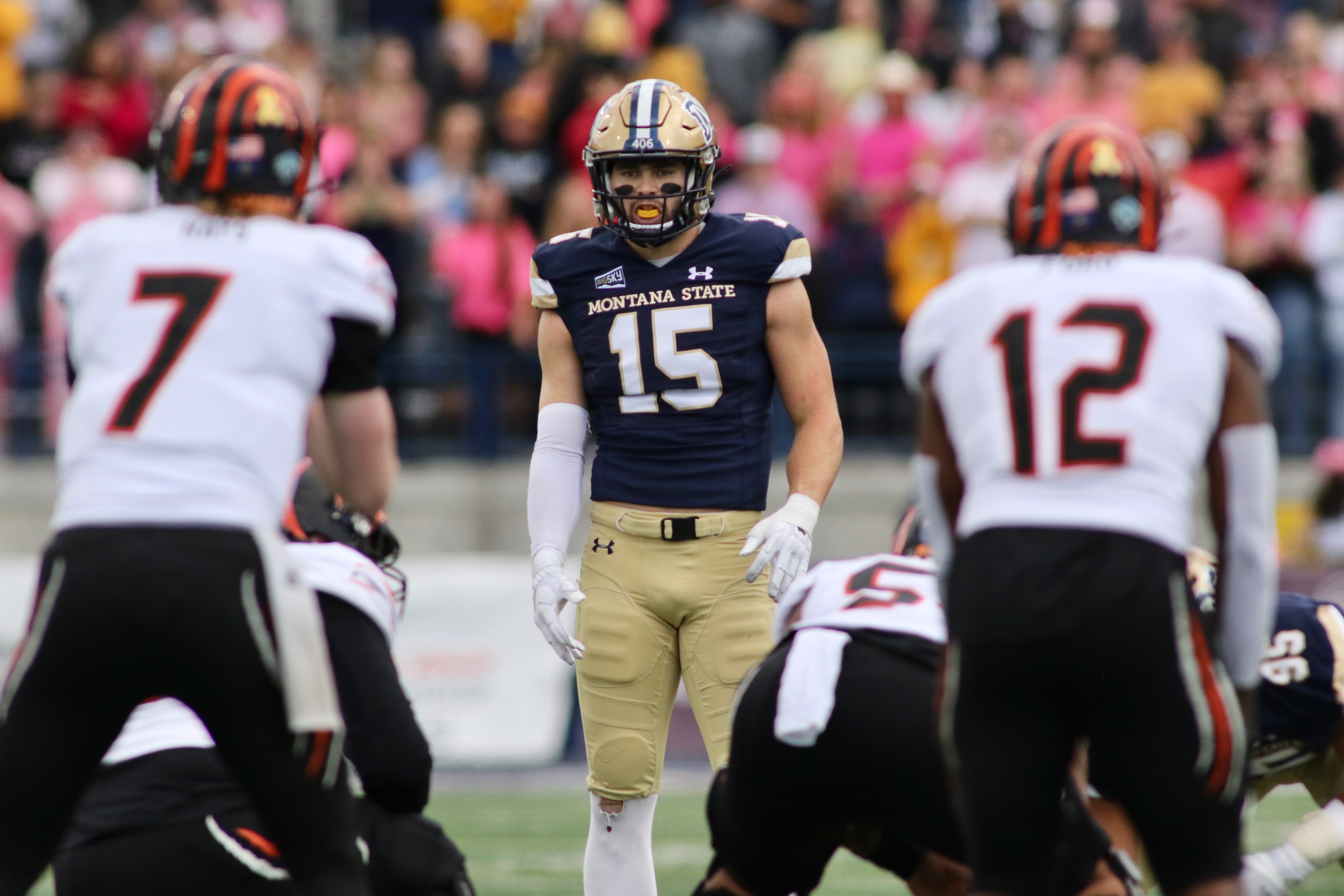
And now, after one of the most unique college football odysseys of the modern era, a Montana-made athlete with a perhaps unrivaled combination of size, speed and explosion that has some advanced analytics evaluators declaring him as one of the most athletic linebacker prospects of the 21st century is set to arrive on the national scene.
Thursday night, the 2022 NFL Draft begins in Las Vegas. Andersen is projected to be the highest player from the Football Championship Subdivision selected since 2017, when national championship-winning quarterback Carson Wentz was selected with the second pick.
“He would start for us at the University of Texas today,” Choate, Montana State’s head coach from 2016 until 2020, said last October. “Most scouts talk to me more about Troy Andersen than anyone on our roster.”
Parker Gabriel, the former Chronicle writer who currently covers the Nebraska Cornhuskers in Lincoln, Nebraska, has said Andersen would start on the front seven for most Big Ten schools ever since the prospect was a sophomore.
Choate agrees, consistently comparing Andersen to the talent Choate saw while coaching in the Mountain West, the Pac 12, the SEC and the Big XII. Choate has compared Andersen favorably in talent and ability to players like Dante Fowler, a defensive end from the University of Florida who Choate coached before Fowler was the No. 3 overall selection in the 2015 draft.
Since the day Andersen stepped on the MSU campus, Choate has thrown around names like Shaq Thomson, Danny Shelton and Vita Vea, each Washington All-Americans who went on to become first-round draft picks or players like Doug Martin, the famed “Muscle Hamster”, a future NFL Pro Bowl running who played at Boise State while Choate was an assistant on Chris Petersen’s staff.
“Troy’s going to have a really, really good opportunity at the next level,” said Choate, who has since moved on to a co-defensive coordinate role at the University of Texas. “And I think the experiences he’s gone through in the last 18 months have prepared him even more to succeed when he gets that opportunity.”
It seemed so unlikely, yet all so fitting for the kid from Dillon to be Montana’s chosen one. Here was a two-way star from one of the Treasure State’s most tradition-laden high school who was a clear next-level talent from the time he was 15 or 16 years old, let alone since the day he stepped onto the Montana State campus.
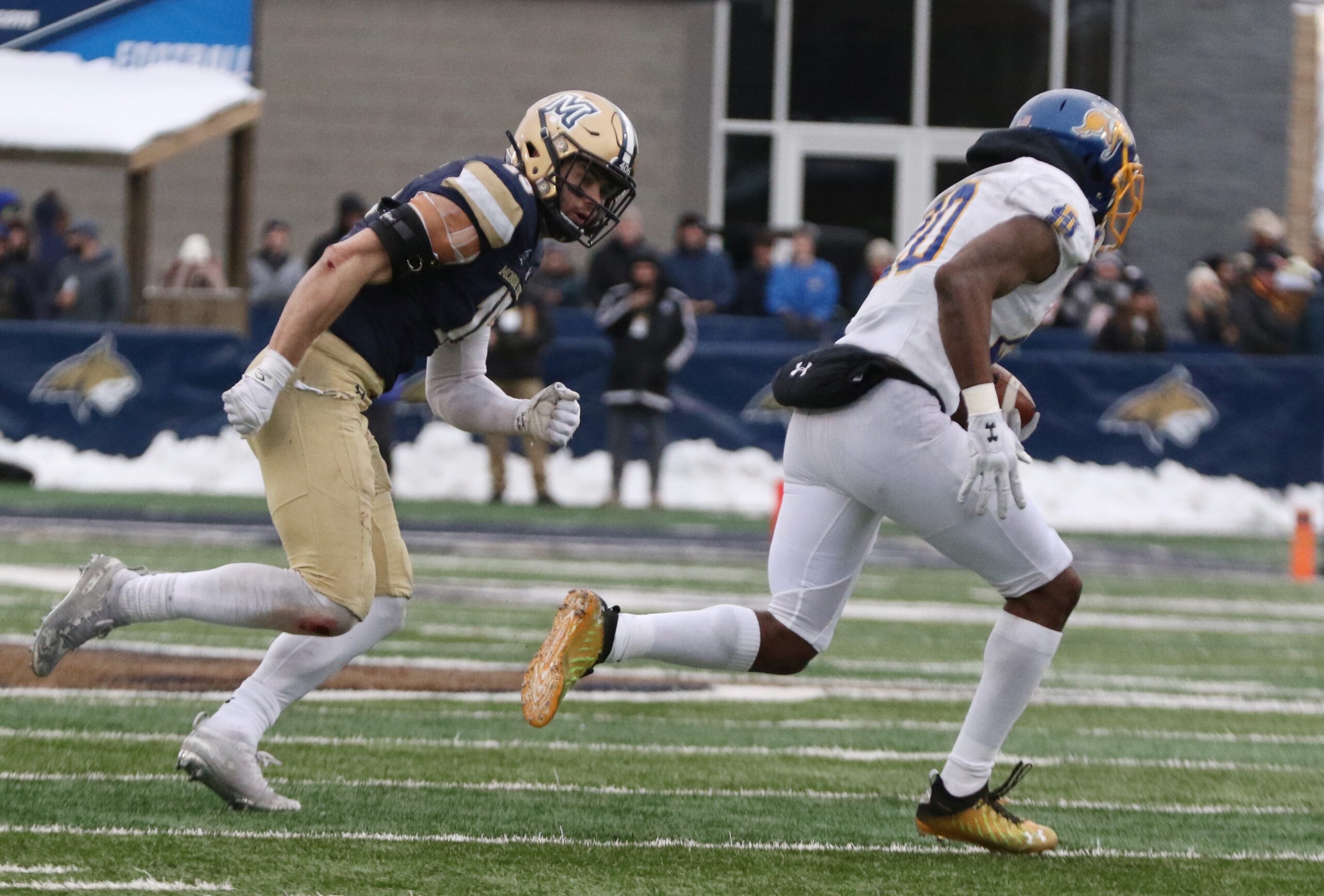
Montana has produced hundreds of elite football players. The Montana Football Hall of Fame cites more than 250 players who either came from in-state high schools or played for an in-state college before making it to the NFL.
So often, those with rare gifts who grew up in the Last Best Place took their talents outside of one of America’s most geographically enormous and culturally mystical places. Yet Andersen chose to stay home and play for the Bobcats, the team he grew up cheering for.
Those who heard the rumblings of this myth coming out of the throwback cowboy town located 75 miles from the Montana-Idaho border in the southwest part of the state, how could they be surprised by anything the prodigy accomplished?
The freak show freshman seemed destined to burst onto the scene instantly upon arriving in Bozeman. Adjusting to life in a booming metropolis (by Montana standards) wasn’t a challenge. Andersen was the valedictorian of Beaverhead County High School and a young man with throwback values.
He was also one of the great prep winners of his generation, helping the Beavers to four consecutive state championship games in football and basketball. He was the quarterback and the point guard on teams that played for state championship teams his final two years of high school, winning two football state titles and a basketball championship.
Travel back to his junior year at the 2016 state basketball tournament in Missoula. On a defensive possession, Andersen rotated backside, leapt to block a shot and nearly hit his head on the backboard. That same tournament, he also had a two-handed dunk that went down far too easy for a kid projected as a defensive front seven football player at the college level.
The display nearly prompted a few of the University of Montana assistant basketball coaches in attendance to contemplate if maybe the power guard should be a Division I basketball recruit, too.
During the spring of his junior and senior years, the 6-foot-3, 215-pound man-child, ran nationally competitive times in the 100 and 200 meters despite not yet possessing a refined running stride.
Choate anointed him early, cultivating Andersen’s burgeoning myth by comparing the rising rookie to the most talented players Choate had coached during a career as an FBS assistant that has cast a wide swath.
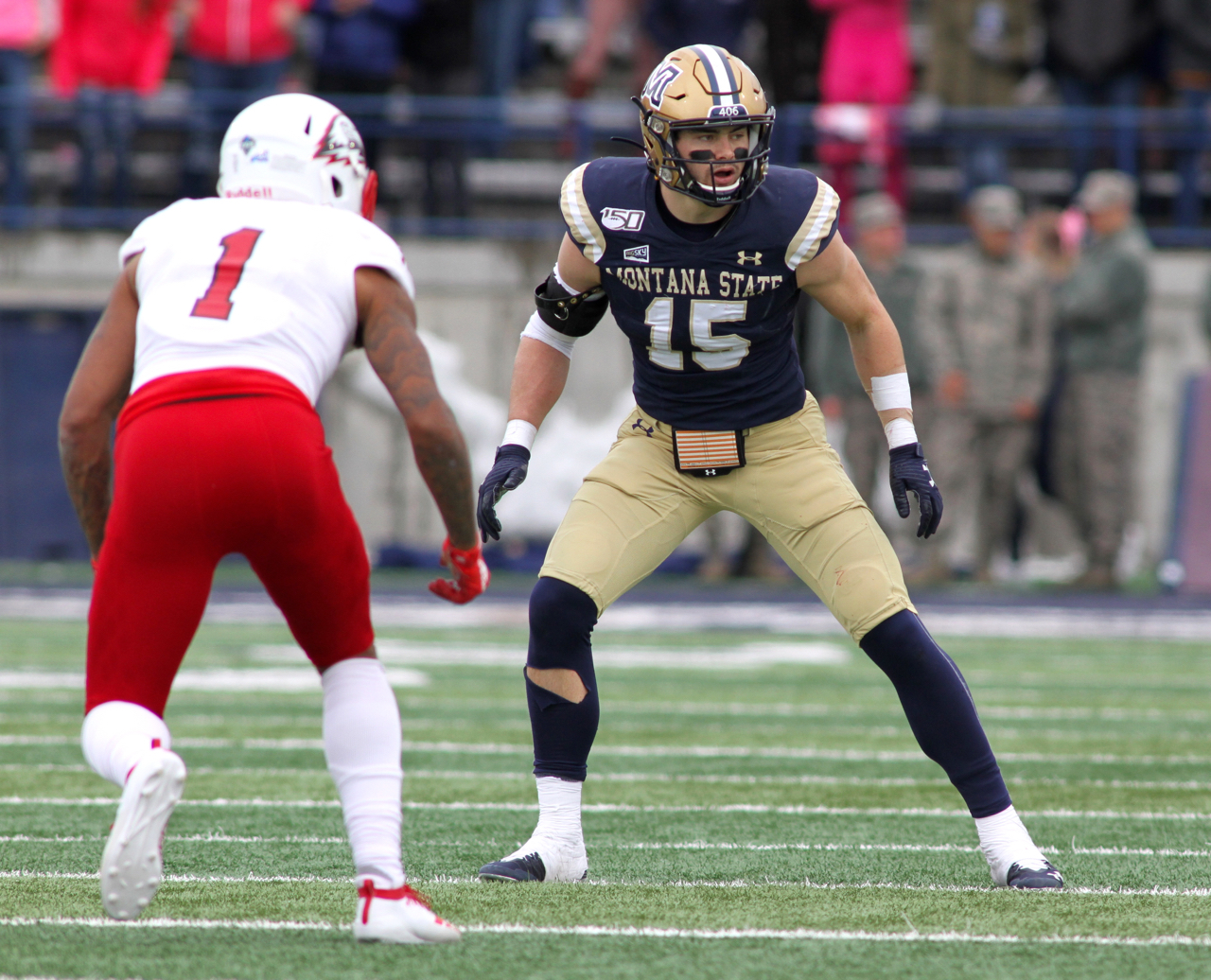
It’s bold to say an 18-year-old has more potential than former first-round draft picks like Fowler or Shelton or Thompson… unless it’s utterly true.
Those who have seen Andersen compete in person in any athletic pursuit at any time over the last seven years has seen an athlete with superior size, strength and speed to the total sum of his competitors while also possessing among the sharpest minds of any athlete in Big Sky Conference history.
“Troy Andersen is Paul Bunyan,” Choate said. “That’s who he is. He’s a myth. He’s a legend.
“And the best part about it is he’s the Paul Bunyan we want him to be. He’s not the Paul Bunyan with the scars and the baggage. He’s the Paul Bunyan you want him to be.”
Like an avalanche ripping out of the Pioneer Mountains, the pressure grew unrelenting, growing in both intensity and scope. The first question after almost every fall camp football practice in August of 2017 centered upon Andersen and the proposition that Choate truly planned to play the rookie on both sides of the ball.
The public’s obsession never lessened. From Andersen earning All-American honors at three difference positions on both sides of the ball to him quarterbacking the Bobcats to one of the most heart-stopping comebacks in the 120-year history of the Montana State rivalry against the rival Montana Grizzlies to Andersen captaining the Bobcats to consecutive historic runs not seen around Bobcat Stadium since MSU last won a national championship in the 1984, the tall tale has no parallel.
None of the hype seemed to affect the cowboy from Beaverhead County. While Choate calls him Paul Bunyan and coaches around the country marveled at the myth, Andersen seemed impervious to being put on a pedestal.
The reason is simple: perhaps the only person who is completely immune from the legend of Troy Andersen is the man himself.
“I’ve never really thought of myself as anything other than a kid playing football with his friends and teammates, trying to have fun and do my best,” Andersen said in November 2021.
“Every opportunity I get, I realize that football is football and I just love playing the game.”
The fresh-faced kid from the town named for Union Pacific Railroad President Sidney Dillon won Big Sky Freshman of the Year. He quarterbacked the Bobcats to their first playoff appearance of Choate’s tenure as a sophomore in 2018, helping MSU post its seventh FCS playoff victory ever that same season.
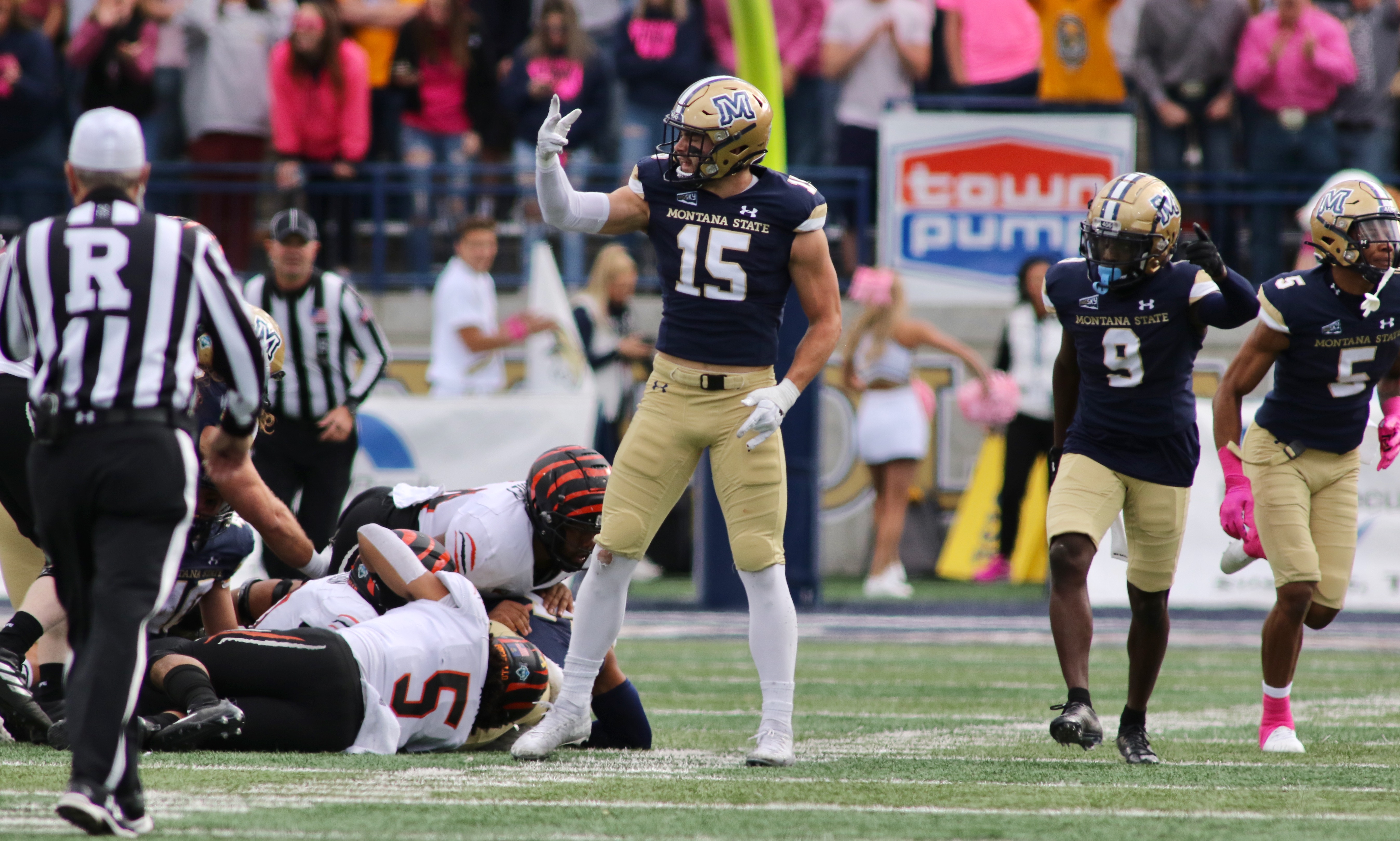
He played both ways at an All-American level as a junior before showing his mortality when he suffered a season-ending injury in 2019.
And after bouncing back from a seemly major setback — Andersen had surgery on his shoulder and for multiple leg injuries between the end of the 2019 season and the beginning of his senior season in 2021 — the myth grew into legend.
He fulfilled the prophecy, earning Big Sky Conference Defensive MVP and finishing as the runner-up in the Buck Buchanan Award, lifting the Bobcats on a run for the ages that culminated in a national championship game appearance to end his senior season in 2021.
Suddenly, what was a rumble amongst Bobcat fanatics grew into a choir of Montana’s proudest singing the praises, validating the teenage anointment as football royalty just a few years before.
Andersen has been impervious to pressure, playing a full handful of positions at absurd All-American levels. He’s done it while shouldering the burden of Choate’s departure and serving as the face of the football program and university. Perhaps just as impressively, he’s done so while maintaining a reputation as one of the top scholar-athletes in the United States.
“If you could build a statue of what a student-athlete should be, you’d build it of Troy Andersen,” Montana State athletic director Leon Costello said in an interview in January leading up to Montana State’s national championship game appearance in Frisco, Texas.
On a recent sunny afternoon at Bobcat Stadium, Andersen appeared in great spirits. He led a speed workout with 10 other former Bobcats, all of whom harbored similar NFL dreams, though none with the sure-fire professional potential of their leader.
The current Montana State squad had just wrapped up its third of five Saturday spring practices. As second-year head coach Brent Vigen addressed the media, answering questions centered upon replacing one of the most decorated senior classes in school history, many of the eyes of reporters couldn’t help but wander over to the aspiring pros.
Andersen seemed loose and happy, wearing a smile most of the time he worked out with his now former teammates. Perhaps his calm came because he had announced to the football world a few weeks earlier in Indianapolis, Indiana what so many around Montana already knew.
While Lewis Kidd, Daniel Hardy, Tre Webb, Amandre Williams, Lance McCutcheon, Chase Benson, Taylor Tuiasosopo and Kevin Kassis all got in one last workout with their respective NFL Pro Day less than 48 hours away, Andersen knew he’d already established himself onto the national radar with a crescendo.
When he place his hand on the turf at Lucas Oil Stadium and flexed his right triceps before exploding out of the blocks like he was chasing another Class A sprinting title, those who had witnessed the growth of a young man into a myth were hardly surprised. And in that moment, the myth from Montana introduced himself to the nation.

“I didn’t know what I had run after I had run the first one, I didn’t really want to know so I didn’t check my phone,” Andersen said following Montana State’s Pro Day in Bozeman six weeks after he took the NFL Combine by storm. “I just figured, I had to go run faster. After the second one, they flashed it on the screen and I thought, ‘That’ll work.’”
Each time the clock flashed, it cued an eruption on Twitter about this little-known linebacker from Montana State. The Combine clock flashed “4.41” on his first sprint, “4.45” on the second.
Although the times were each adjusted 0.01 seconds, the commentators and pundits could hardly catch their breath. A pair of sub-4.45 second times in the 40… a 10-foot-8 broad jump… a 36.5-inch vertical for a prospect that measured in at nearly 6-foot-4 and 243 pounds… a prospect who holds a resume like none other with decoration at four positions… it all helped the homegrown Montanan become the talk around the National Football League.
“Despite also playing quarterback and running back in college, Andersen is one of the top off-the-ball linebackers in the class,” wrote NFL Draft guru Todd McShay. “He flies all over the field and is always around the ball,” later tweeting that Andersen was a Day 1 starter in the NFL.
“He did everything at Montana State and to run 4.41 and have the ability he’s shown in coverage to be an every-down guy, he was one of my off-the-script guys,” added NFL Draft expert Mel Kiper. “You have to love everything about this kid. He will tackle well, he will get interceptions, he will be disruptive to the quarterback with that length and he can get sideline to sideline with that speed. It’s not an exaggeration that he’ll be mid-second round and I think pretty early as a Friday pick.”
The NFL Draft begins Thursday night, April 28, 2022. It’s unlikely Andersen will be on the board after Friday when the second and third rounds play out. The linebacker will almost certainly be the highest draft pick out of the Big Sky Conference since 2017, the year the Los Angeles Rams used the 69th pick of the third round to select a particular record-setting wide receiver out of Eastern Washington who just so happened to win Super Bowl MVP honors this past January.
“Troy is the defensive version of Cooper Kupp,” said Mike Kramer, one of the resident historians of the Big Sky Conference after playing at Idaho in the 1970s, serving as an assistant at Montana State and Eastern Washington in the 1980s and 1990s before winning Big Sky Conference Coach of the Year as the head coach at EWU (1997), Montana State (2002, 2005) and Idaho State (2014). Kramer has spent recent years as a contributing analyst on ESPN Montana radio and television.
“You start to watch him closely and you watch his footwork and you watch the way he handles himself and you watch his balance, his coordination, his explosion, you see how square he stays to the line of scrimmage, how well he runs.
“Then you start to see why for years the Bobcats would play him at quarterback or at running back. He can do all those things. He has great ball skills. But he also moves at pad level, he doesn’t hurry, he doesn’t run helter skelter, he doesn’t push himself out of position just because he has elite speed. He also has a great sense of leverage to the ball as a linebacker should.”
Kramer has an intimate knowledge of the Northwest. Growing up in Colton, Washington, he chose to play offensive line for Ed Troxel at Idaho over an offer from Jim Sweeney to play at Washington State back in the early 1970s.
From a stop as an assistant and then head coach at Helena High from 1977 until 1982 to a defensive assistant role on Dave Arnold’s staff at Montana State (the Bobcats won the 1984 national championship with Kramer as the defensive line coach) to a return to Bozeman as the head coach 16 years later (2000-2006), the Big Sky lifer has deep ties to Montana.

Combined that affinity with all the times Kramer had an eye on the Treasure State from the enemy sideline between living in Cheney, Washington and Pocatello, Idaho, the man dubbed endearingly as the “Big Human” has a keen eye and extensive insight into small-school prospects from the region, particularly Montana.
“Troy reminds me a little bit of Leighton Vander Esch who played at Boise State and came out of Riggins, Idaho (Population: 419). Like Vander Esch, Troy was a small-town, multi-sport athlete who was a great basketball player,” Kramer continued. “He did not come up in a high school program where all he did was lift weights, watch video and go to football camps. He has a well-rounded athletic persona to him and that’s going to blend into his opportunity at the next level.”
So many players who grow up in Montana come to the Bobcats or the Grizzlies as raw, underdeveloped prospects, often times three-sport athletes who have never specialized, small-town kids who have had only rudimentary strength and speed training.
Dane Fletcher excelled at baseball and hockey growing up in Bozeman before transforming into an All-American edge player at Montana State and a starter at inside linebacker in Super Bowl XLVI for the New England Patriots.
Mike Person was a partial scholarship offensive lineman from Glendive who went on to captain the Bobcats to the 2010 Big Sky Conference championship before embarking on a 9-year NFL career.
Future Pro Bowl wide receiver Marc Mariani of Havre; future six-year NFL running back Chase Reynolds of Drummond; future nine-year NFL safety and special teams ace Colt Anderson… all three came to the University of Montana as walk-ons and all three went on to have successful careers in professional football.
Other precocious high school Montana athletes who had the unlikely fortune of being discovered often went elsewhere. Miller, the Helena Capital star who won multiple state championships in multiple sports, went on to rewrite the record books at Boise State. The towering Brock Osweiller first emerged on the scene as a star basketball player at Kalispell Flathead, earning an offer from Gonzaga as a freshman before eventually landing as a quarterback at Arizona State.
Osweiller transformed into a three-year starter at ASU before becoming a second-round draft pick thanks in part to former MSU quarterback and College Football Hall of Fame head coach Dennis Erickson plucking him out of the Flathead.
Andersen fits neither mold. He was not a late bloomer who exploded onto the scene after a few years toiling in the dark. He did not need a college training regimen to overpower his opponent. Andersen was the most physically dominant player in the Big Sky Conference from the day he became a college football player. And, despite playing four different positions for two coaching staffs while fighting through constant injuries, he never was anything but the best player in the league.
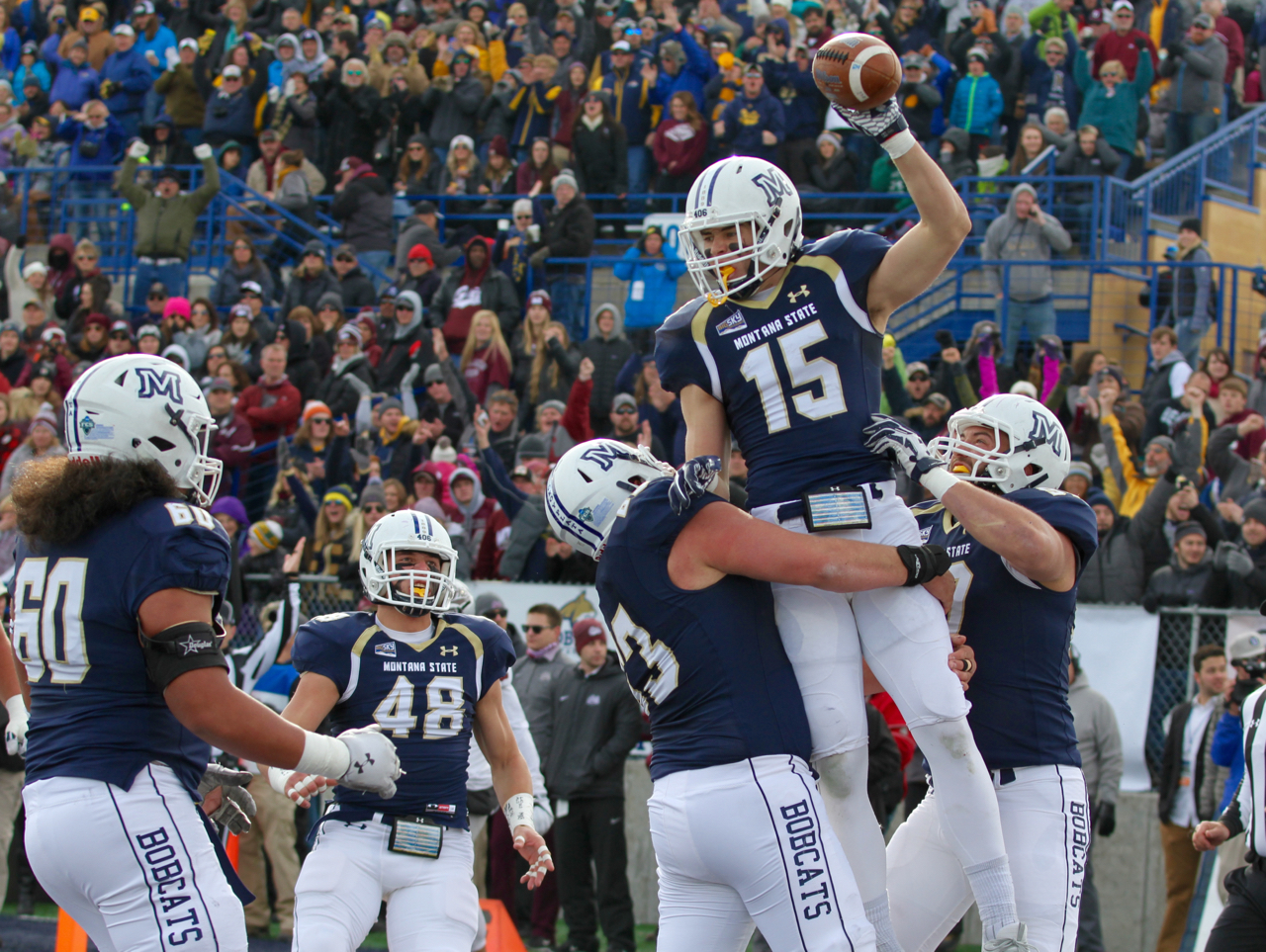
Just ask North Dakota’s linebackers. Andersen simultaneously out-ran all of them on a 27-yard touchdown sprint, the first of his college career, as part of his first 100-yard rushing outing in his second-ever collegiate game. Andersen suffered a shoulder ding against Washington State in his college debut, hardly played the next week, then freaked out in MSU’s conference opener, rushing 22 times for 131 yards in a resounding win at UND, a team that had gone undefeated in Big Sky play the year before.
Or ask Northern Arizona’s offensive line, whom Andersen dusted for his first two career sacks as a rookie. Or ask Dante Olson and the Griz defense, a unit that couldn’t contain the cowboy quarterback in 2017 or 2018. Andersen gave it to the Grizzlies at both running back (two touchdowns in 31-23 win in Bozeman in 2017) and quarterback, the position from which he orchestrated the “Miracle in Missoula” comeback at Washington-Grizzly Stadium in 2018 thanks in large part to the best throwing performance of his brief time under center.
Or ask the dozens of offensive players Andersen has chased down, the number of angles he’s erase, the number of first downs he’s robbed opposing offenses of while he rolled up more than 200 tackles and earned two more All-American honors, one at outside linebacker in 2019 and one at inside linebacker in 2021.
Ask Isaiah Davis, the South Dakota State all-conference running back Andersen tracked down for a loss on a fourth down run play, bringing an already raucous Bobcat Stadium crowd to bedlam as MSU surged past SDSU 31-14 and into the FCS National title game on a play that many might say was Andersen’s trademark moment in his fabled career.
Now Andersen sits on the brink of making history once again. The highest drafted native Montanan who also played college ball in Montana during the Big Sky era (dating back to 1963) is Kroy Biermann, a Buck Buchanan Award-winning defensive end from Hardin who walked on to Montana before becoming the 154th pick in the fifth round of the 2008 NFL Draft by the Atlanta Falcons.
READ : A Rancher Runs Through It: Troy Andersen meets the world
“He’s built the way they are supposed to be built,” said Choate, who guided the Bobcats to consecutive playoff appearances in 2018 and 2019. “Not just from an athletic standpoint, but he gets what it means to be a part of a team. He’s humble and hungry. When the game is on the line, he wants to be the guy who affects the game but he doesn’t need it to be about him.
“Those are all very unique and special qualities, especially in this day and age where everybody’s got to get on Instagram and show their picture of them making play. I have a ton of respect for him.”
Running back Milt Popovich, a Mining City native deemed the Butte Missile during his five seasons with the Chicago Cardinals, was the No. 15 overall pick in the 1938 NFL Draft out of UM. Back then, there were only 10 picks in the first round.

“Paul Bunyan was born in Maine. When three weeks old, he rolled around so much in his sleep that he destroyed four square miles of standing timber. Then they built a floating cradle for him and anchored it off Eastport. When Paul rocked in his cradle it caused a seventy-five foot tide in the Bay of Fundy and several villages were washed away. He couldn’t be wakened, however, until the British Navy was called out and fired broadsides for seven hours.
When Paul stepped out of his cradle he sank seven warships and the British government seized his cradle and used the timber to build seven more. That saved Nova Scotia from becoming an island, but the tides in the Bay of Fundy haven’t subsided yet.”

What we collectively witnessed after Andersen blew up at the NFL Combine is the evolution of a myth turning into a modern-day legend. The lore has been brewing for years. As the world trends toward technology, away from living off the land, Andersen’s background as modern-day cowboy stands in stark contrast, even unique, to so many other young men who will have their names called the final week of April. As the world sometimes seems like it’s dictated by tweets and memes, his family has existed around rotating pastures and mending broken fences.
His point of origin is the idyllic cowboy town most well-known for high school state championships of all sorts, a Labor Day rodeo and a famed taco truck. Those rural roots instilled a strong work ethic into Andersen’s fiber.
Troy’s father, Scott, told the Bozeman Daily Chronicle that his son had a knack for “running the swather (on the ranch) as good as anybody” from a young age. When Troy was younger, his parents would assign him and his older sister Holly, to see which of their cows had given birth to new calves. Each time there was a new baby, the mother would be tagged with a color coordinated code on her ear. While the rest of the Andersen family would write down all the cow codes, Troy instead memorized each cow and its new baby, according the profile written by Paul Schedelson of the Chronicle in the fall of 2018.
It was an early example of Andersen’s mental acumen and a foreshadowing of the cerebral element that allowed him to play more positions more effectively than arguably any college football player in the 21st century.
The isolation of working cattle in the rolling hills of the Beaverhead Valley helped craft Andersen’s quiet, humble personality and diligence in daily life. He and his sister Holly, who would go on to run track at Montana State — willingly helped their parents. Sometimes Troy would send his parents text messages inquiring if he could knock off work early to go to open gym. Mostly, Andersen would work until the work was finished.
“I think just how hard my parents worked our whole lives, getting up early always because animals depend on you to survive. You can’t really take a day off,” Andersen said. “That definitely rubbed off on me.”
Since the turn of the 21st century, Beaverhead County High has had as much athletic success as any school in Montana. Dillon won five Class A state football titles and played for seven before Andersen got to high school.
Beaverhead County has 11 state basketball titles and 17 state title game appearances to its credit, including eight appearances and six titles before Andersen was born on April 23, 1999. Andersen was a kid when Dillon won Class A basketball titles in 2007, 2009 and 2012.
Andersen remembers looking up to Tyler and Torrey Thomas, the sons of Dillon Hall of Fame head football coach Terry Thomas. Coach Thomas led the Beavers to three state championships, including titles in 2000 and 2003 that his sons were a large part of before each went on to star at safety for the Griz.
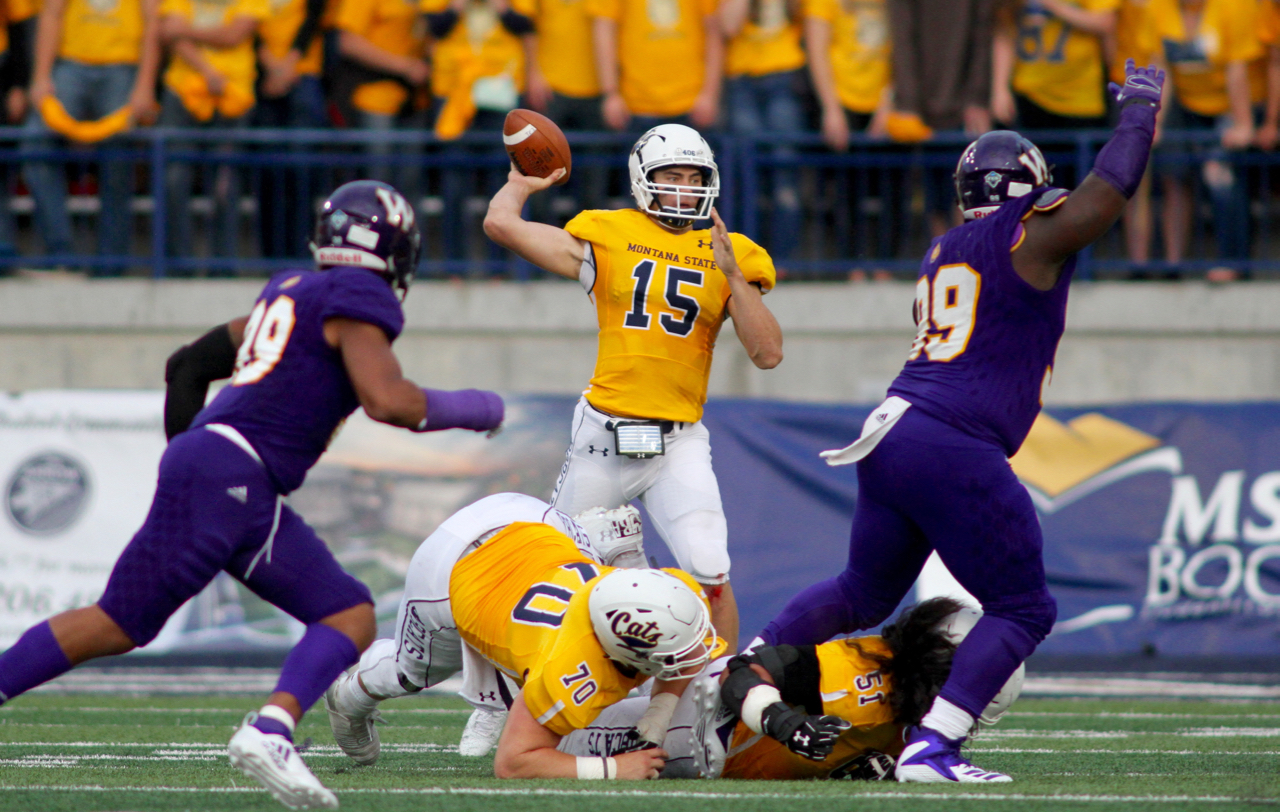
Andersen also admired players like Zac McCrae, who helped quarterback Dillon to state championships in 2005 and 2006 plus a runner-up in 2007. And local stars like J.T. Linder and Wes Knox, who were on the 2011 state title team and the 2012 squad that finished as state runners-up.
“You don’t want to be the next great that screws it up,” Andersen said with a chuckle. “You have a good culture, a culture of winning, but you look up to the kids that are older than you and you want to be like them and you learn to be like them.”
Between 2013 and 2016, Andersen was part of three state championship teams and one – his sophomore year in 2014 – that finished as the Class A runner-up. The Beavers lost in the state championship hoops game in 2014 to Columbia Falls and Laurel in 2015 before breaking through to defeat Billings Central Andersen’s senior season in 2016.
“All of his physical gifts aside, he’s just a winner,” says R.J. Fitzgerald, a Dillon product who was a year behind Andersen and is now a captain fullback for the Bobcats. “All he cares about is winning. He’s obsessed with it and he’s so good at it.”
Rick Nordahl — an assistant or head football coach at Beaverhead County High for 28 years including serving as the head man Andersen’s four prep seasons — remembers thinking Andersen had rare talents at an age so young most kids hardly understand much about the gridiron.
Part of Dillon’s success has been the athletic opportunities provided when kids first enter school. The town of about 4,500 has a flag football league where the youngest age group includes pre-kindergarten, preschool, kindergarten and first grade. Kids get an opportunity from a young age to compete against others several years older than they are.
“My son, Todd, and Troy are the same age and I remember all the way back to when he was in kindergarten or first grade, we could we could see right away,” Nordahl said in the days leading up to the NFL Draft. “Troy was always ready to compete and he had a lot of kids, in his class, in the classes above, the classes below, very athletic classes from a young age.
“He instantly stood out, especially even when he was running down kids or his pursuit angles, to get flags. And sometimes he couldn’t slow down, so he got a little rough at times with some of the other kids just because he couldn’t control his speed. He really couldn’t. He was that fast, even when he was like six or seven years old.”
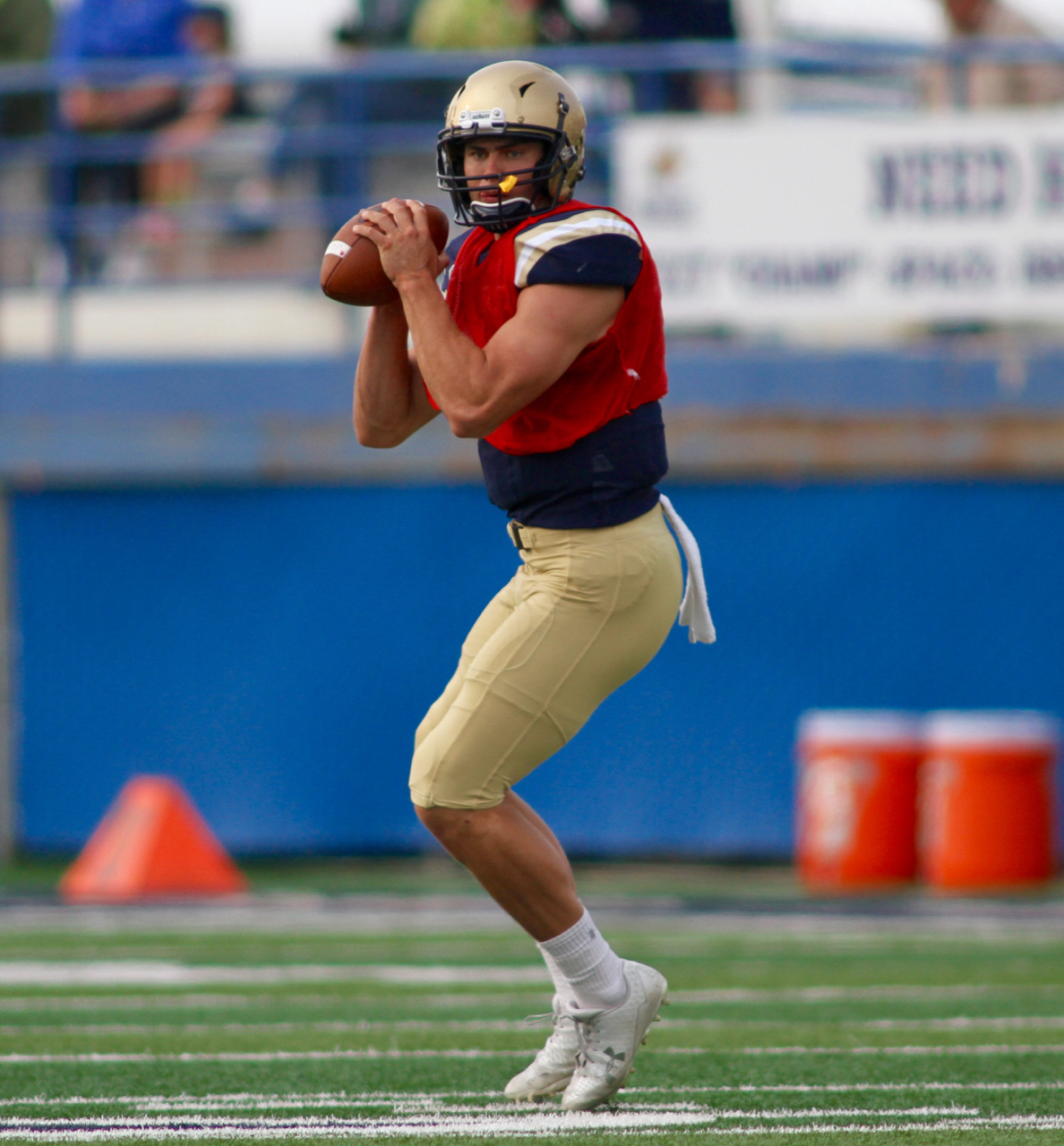
That speed and aggression made “some of the parents get upset,” Nordahl said, going on to emphasize it was not because Andersen was unruly or mean or misbehaved.
“It was just that he didn’t have a shutdown. He didn’t have a different speed. He literally couldn’t slow down,” Nordahl, who spent years as Terry Thomas’s defensive coordinator to his time as the head coach when Thomas retired in 2013 until Nordahl retired in 2018 following four state championship game appearances and three state titles as the head coach.
“Even before he was old enough to really read, even at that age, I said that will probably be the one kid from Dillon that makes it in the NFL.”
Quite the prophecy from the head coach, yet one that would come to fruition over the next 15 or so years.
Because of Nordahl’s involvement with the Beaver football program and the fact that his son, was the same grade as Andersen meant the coach had a front-row seat to watch Troy’s rise. As seventh and eighth-graders, Troy, Todd, Fitzgerald and their classmate would spend a lot of time around the football program. Nordahl remembers “a group of 10 or 12 eighth graders that started coming in spring and would spend a couple nights a week in the weight room.”
The workouts weren’t meant to build strength, but rather teach correct technique, the coach said. And that diligence plus the burgeoning group bond translated to “about 25 of those kids making it all the way to senior year, very competitive, very good, very close group throughout their four years of high school.
“That’s what set the table for us to play for four state championships and win three those years,” Nordahl said
The Beavers established a true Class A dynasty in football and basketball. Yet Andersen’s ferocious appetite for winning was most on display on the track, simply because track is a sport where talent and athleticism are proven in stark, non-negotiable numbers.
The videos of Andersen during regular-season meets are almost laugh out loud. He doesn’t just dust the competition; he looks like a super-sized man with a baby face running against a bunch of teenagers.
He first broke 11 seconds in the 100 meters in the first track meet of his senior year. Later that spring, he ran 10.88 in the 100, 22.11 in the 200 meters and threw the shot put almost 48 feet… on the same day of the Class A state meet in Laurel. That shot put heave came in just the fourth time he had ever competed in the event in a meet.
“His senior year, he needs another event for state so three weeks before state, he picked up the shot put and I mean, everybody in the state just went insane,” Nordahl said. “Here’s a kid running 10.88 (seconds in the 100) and all of a sudden, he passes the shot put pit, decides to pick one up, places (sixth with a throw of 47 feet, 5.5 inches) at the state meet.

“I mean, it’s ridiculous. He only missed the school record by a couple feet,” Nordahl continued, unable to hold back a laugh at the absurdity of the story.
The unpolished speed and power, the diverse talent helped Choate and his staff know they should go all-in on recruiting Andersen. Plus, Choate has Dillon ties – he played linebacker at Montana Western and married a local girl.
When Andersen first earned an invite to come to MSU’s individual camp just a few months after taking the state track meet by storm in the spring of 2016, he was just starting to become the talk of towns around Montana other than the one he grew up in.
At the individual camp, Choate told his assistants to put Andersen in as many unorthodox situations as possible. Andersen had played wide receiver his freshman and sophomore years of high school. As a junior, he shifted to quarterback and safety.
Early on that June day in 2016, Montana State defensive backs coach Gerald Alexander ran Andersen through a battery of secondary drills at safety and nickel back.
Choate recalled that Alexander’s analysis of the enigmatic small-town athlete was: “Oh yeah. He’s a dude. He can probably play safety, he can probably play linebacker, he can probably play receiver, he can probably play tight end.”
The Bobcats offered Andersen that day. He gave Montana half a second at the table to try to sway him before committing to the school where his older sister, Holly, was already on the track team. Andersen’s talents were not seen outside Montana’s borders until he started playing college football.
The commitment launched a one-of-a-kind career in which Andersen played consequential snaps at quarterback, Wildcat quarterback, running back, outside linebacker on both the strong and weak sides, “Buck” defensive end, and most recently, Mike, or middle, linebacker.
“At that time marking logs was not thought of, Paul had no need for identification when there were no logs but his own. About the time he started the Atlantic Ocean drive others had come into the industry and although their combined cut was insignificant compared to Paul’s, there was danger of confusion, and Paul had most to lose.
At first Paul marked his logs by pinching a piece out of each log. When his cut grew so large that the marking had to be detailed to the crews, the “scalp” on each log was put on with an axe, for even in those days not every man could nip out the chunk with his fingers.”
Running back happened by circumstance. Quarterback happened by necessity. Outside linebacker happened because of talent. And inside linebacker happened because of desire to prove it’s the position he belonged all along.
In the summer before Choate was set to open his second fall camp as head coach in Bozeman, running back Nick LaSane, a senior intending to be MSU’s short yardage specialist, had a run in with the law, earning him a four-game suspension to begin his senior season.
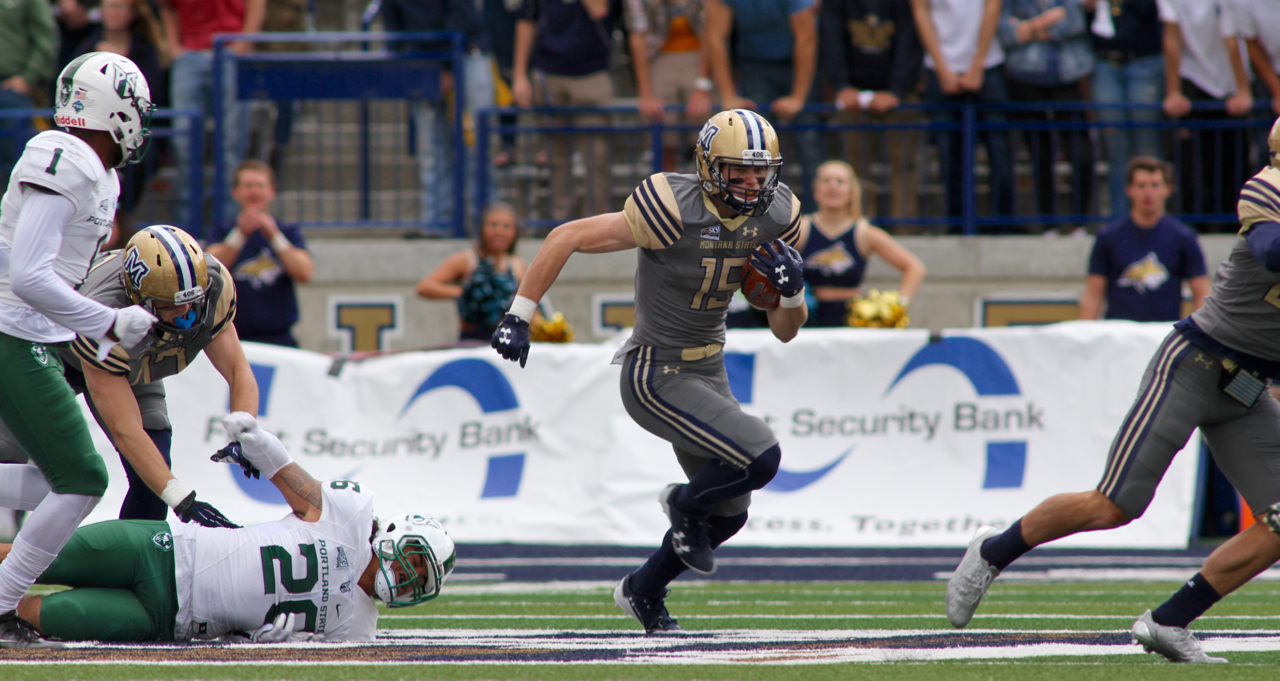
Choate had already been salivating at opportunity of putting Andersen, the talk of camp and the gem of Montana, at tailback. Now the opportunity was also an obligation.
When asked what he liked about what Andersen brought to the tailback position, Choate helped pen his first chapter in the myth-making of the kid from Dillon.
“I like everything about Troy Andersen,” Choate said following the first college practice of Andersen’s MSU career in August of 2017. “I like the fact that he’s never had a B in his life. I like the fact that he’s 6-foot-3, 215 pounds and can run a 10.8 100 in Montana in a blizzard in Belgrade in March.
“I just think he has a great demeanor, he’s a tremendous young man. He’s a winner. He has got tremendous lower body strength. He’s a next level athlete and that’s a fact. Quite honestly, I think some people missed on him. Their loss is our gain. I think if he ends up playing his whole career at running back or we have the luxury of getting that backfield squared away and sliding him over to defense, as long as he can stay healthy and continue to mature and grow, I think he has a high ceiling.”
Andersen suffered a ding in his first college game, a 31-0 loss at Washington State. That injured shoulder held Andersen to just two carries and five yards in a 31-27 home loss to South Dakota State, a game in which enigmatic quarterback Chris Murray threw for more than 300 yards and four touchdowns.
The following week against UND, Andersen rushed for more than 100 yards, the first of 11 games he surpassed the century mark on the ground in his career. By the time his freshman season was finished, he had 515 rushing yards and five rushing scores, including a pair of scores against the Grizzlies, marking MSU’s second straight rivalry victory after only beating Montana twice in nine seasons under Rob Ash, Choate’s predecessor.
The two-way Sam linebacker also had nine tackles, a pair of sacks and plenty of special teams plays on the way to earning Big Sky Conference Freshman of the Year.
After supper they would sit on the deacon seat in the bunk shanty and sing “Shanty Boy” and “Bung Yer Eye” till the folks in the settlements down on the Atlantic would think another nor’wester was blowing up.”
The Big Sky Conference has played an unbalanced football schedule since expanding from nine to 13 teams before the 2012 season. Sometimes, conference members don’t play for years.
At the Big Sky Kickoff media conference in Spokane, Washington in July of 2021, Portland State quarterback Davis Alexander and defensive back Anthony Adams – both All-Americans – sat at the PSU table chatting with this reporter after their formal interviews were complete.
When the unbalanced schedule was brought up, Alexander exclaimed, “We haven’t been to Bozeman since I was a freshman. That day, it was so windy! (Montana State rushed for 403 yards in a 30-22 win that blustery day in October 2017). I don’t think we’ve even played Montana State since then.”
“Oh YES WE HAVE!” Adams interrupted “We played those dudes in 2018 in Portland when they had that horse-man playing quarterback!”
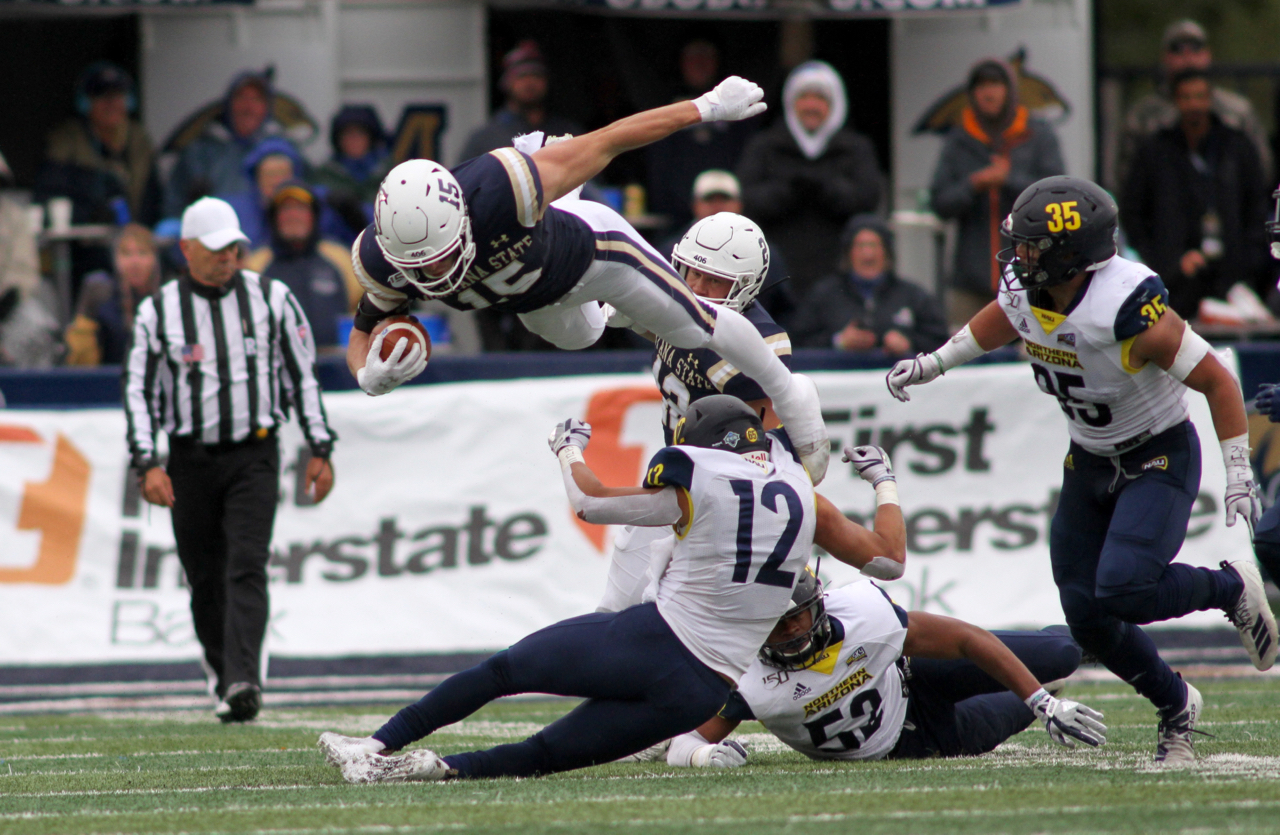
That afternoon in Portland, MSU opened up conference play with a resounding 43-23 victory over the Vikings thanks to 211 rushing yards and two rushing touchdowns by Andersen. The yardage total broke Chris Brown’s record for single game rushing yards by a quarterback. Brown set his mark while operating Cal Poly’s vaunted triple option. Andersen’s effort came in the midst of modernizing the Wing-T out of the shotgun.
His Portland State outburst — which came after he missed two starts under center while recuperating after putting the Bobcats on his back during a 24-carry, 145-yards, two-touchdown effort to help MSU outlast Western Illinois 23-20 in the 2018 season opener — sparked a run that might never be replicated in the conference or the FCS.
“I’m pretty sure No. 15 was a running back and maybe even a linebacker,” South Dakota State head coach John Stiegelmeier questioned during an interview following MSU’s WIU win in the lead up to the Jackrabbits Week Two game matchup against the Bobcats, although Andersen did not play quarterback in that game, instead playing with a cast, carrying the ball twice at running back and notching a sack on defense. “(Andersen) looks more like a linebacker or a defensive end.
“Whatever the heck they have him play, he’s a helluva football player.”
The following week, Andersen scored a 57-yard touchdown as a running back while Tucker Rovig had one of his best games at quarterback in a win over Wagner.
Against PSU, Andersen returned to quarterback, sparking an unforgettable and anomalous run. Over the next 10 weeks, the drive, power, force and explosion Andersen ran the football with became the stuff of Big Sky legend. He carried the ball a jaw-dropping 177 times for 1,207 and 18 touchdowns. He averaged 6.8 yards per carry and 121 rushing yards per game, lining up in shotgun against defenses with most of their players in the box to stop the powerhouse.
He ended his sophomore year as a unanimous first-team All-Big Sky selection as an all-purpose offensive player — an all-conference spot the league’s coaches created specifically for Andersen — thanks to 1,421 rushing yards (league record for a quarterback) and 21 rushing touchdowns, the latter of which broke a record set by Don “The Iron Tumbleweed” Hass back in 1966.
Following Andersen’s 104-yard, three-touchdown rushing effort in a 35-7 win over Northern Colorado — he also threw a touchdown that afternoon — former MSU tight end Connor Sullivan tweeted a side by side of two photos.
In one photo: the famed Time Magazine cover from June of 1973 of Secretariat with the cover art “Super Horse” following Secretariat’s famed run to the triple crown.
The other photo: Andersen running in the open field looking for a soon to be helpless defender to mow down.
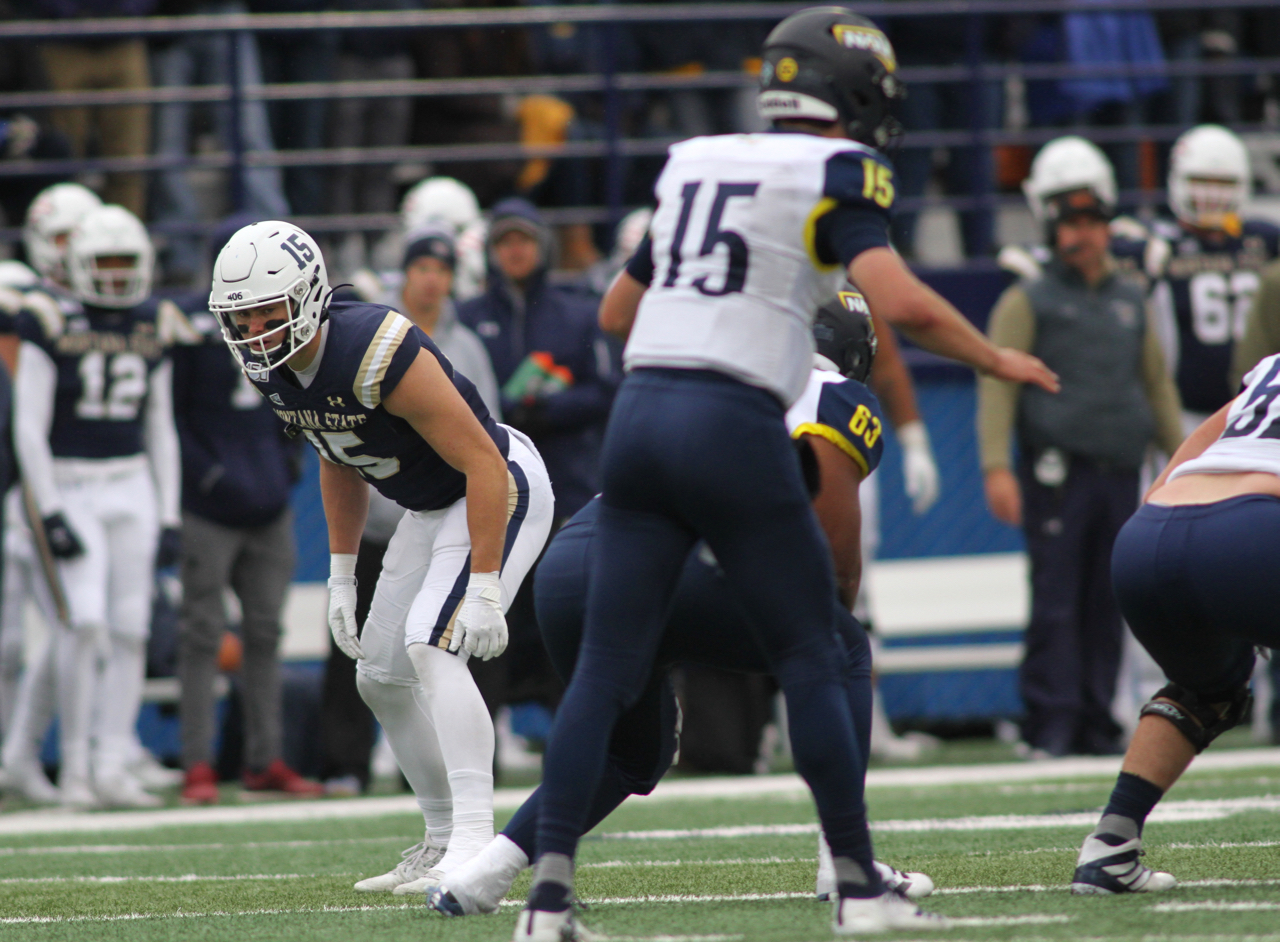
“That kid is totally unique,” Weber State head coach Jay Hill said that season. “Last year, he was their starting tailback and it’s really rare you see a guy go from tailback to starting quarterback the next year, especially when he was recruited to play and probably should be playing defense. But he possesses the ability to throw the ball too. And he’s an unreal leader. That’s what makes him so unique.”
Fitzgerald, the Dillon product who had been Andersen’s backfield mate for more seasons than any other Bobcat, replied to Sullivan’s tweet with the picture of a centaur.
Northern Arizona defensive back Anthony Sweeney would likely corroborate that analysis, since he probably felt like he got kicked in the head by a horse when Andersen knocked Sweeney unconscious with what amounted to a flying knee to Sweeney’s head on one particularly brutal run in a Montana State win in 2019 when Andersen was playing both ways full time.
“That quarterback is such a special, one of a kind player, a tough guy who defines what Montana State football is all about,” Incarnate Word head coach Eric Morris said following his team’s 35-14 loss to Montana State in the first round of the 2018 playoffs, marking MSU’s first playoff win since 2012. Andersen rushed for 84 yards and a score in that victory.
Even in Montana State’s 2018 season-ending 52-10 loss at the hands of FCS juggernaut North Dakota State, Andersen still looked like the most superior athlete on the field. He rushed for 129 yards, including a 52-yard touchdown, while also throwing for 124 yards in what would ultimately be his final game as Montana State’s starting quarterback.
He ended his sophomore season with his second All-Big Sky nod at a second position, and his first All-American honor. That early-career campaign left Andersen with nearly 2,000 career rushing yards and 26 career rushing touchdowns, both already Top 10 marks in Montana State history at positions he never expected to play at the college level.
“When they go for it on fourth down and don’t get it and this dude, the quarterback, stays on the field and puts his hand down and plays some defensive end, then lines up at outside linebacker and has a tackle for loss on our next third down, I’m thinking, this is unbelievable,” Eastern Washington head coach Aaron Best said, reflecting on a 34-17 win over Montana State in Bozeman that marked the only time in the last 10 weeks of the season Andersen rushed for less than 100 yards. Even then, he finished with 94 on the ground.
“The starting quarterback for a playoff team had a tackle in the backfield to force a punt. Think about that.”
The height, weight and chest measurement of the Seven Axemen are not known. Authorities differ. History agrees that they kept a cord of four-foot wood on the table for toothpicks.
Finally, his junior year in 2019 would be the year Andersen got to play his natural position. Leading into that season, Montana State had elevated expectations because of Choate’s recruiting prowess and his ability to sell his vision to the masses, plus the postseason win that came a week after the thrilling comeback to beat the Griz for the third year in a row.

Ty Gregorak, a man who had coached dozens of All-Big Sky linebackers during his 12 seasons as an assistant at Montana, a coach who mentored NFL players like Brock Coyle and Jordan Tripp, could not wait to work with the prospect.
Before the season even began, Andersen’s myth had penetrated Big XII Country. Before the 2019 season opener against Texas Tech in Lubbock, Red Raiders head coach Matt Wells heaped praise.
“Troy Andersen is kind of the modern-day hero in my opinion,” Wells said in his opening statement of leading up to the 2019 season opener for both teams.
“A true two-way player. I’ll say it in Big XII country here.: He’s like the mountain version of (former Kansas State offensive Swiss Army knife) Colin Klein. Big, strong, athletic… but Colin didn’t play linebacker. This guy will play both ways, a lot.”
The crux of Andersen, what makes him truly unique: you can find comparisons across football of players who play multiple positions. But finding an NFL linebacker who could quarterback a team to the playoffs is a complete anomaly. Think of Klein or Colorado’s Kordell “Slash” Stewart playing dozens of snaps at inside linebacker. Imagine BYU multi-tool Taysom Hill trying to make a game-changing impact on defense. Better yet, imagine most any NFL linebacker trying to play quarterback at an All-American level. It’s borderline laughable.
As a junior, Andersen’s offensive load was relatively reduced while he burst onto the scene as one of the best edge players in all of these United States. Primarily playing Sam linebacker, Andersen rolled up 6.5 sacks and 11.5 tackles for loss among his 54 total tackles. He broke up five passes and intercepted another one. He still rushed for 336 yards, averaging 6.9 yards per carry and scoring seven rushing touchdowns, giving him 33 rushing scores, the second-most in Bobcat history behind only Cody Kirk.
Early in his junior season, season, he had his first sack as a full-time defensive starter.… in the same game he rushed for 102 yards and two touchdowns. On six carries. In a 38-17 win over a ranked Southeast Missouri squad.
“Those of us who have watched him since second grade just baffle everybody around him, it’s been neat to watch it progress through junior high, through the high school level,” Nordahl said. “Then he goes tot eh Big Sky and you don’t do this – It’s Division college football. I don’t care what level you play at, you don’t play running back, outside linebacker, quarterback, middle linebacker, you don’t do that. And this guy is out here making a mockery of every team in the Big Sky.”
As his instincts started to meet his preparation, Andersen started translating his talents into prolific performances. He rolled up 10 tackles and one tackle-for-loss in a win over Cal Poly. He had 12 tackles, 2.5 sacks and an additional tackle-for-loss the following week against North Dakota.
The 2019 UND game — MSU’s first in Grand Forks since routing the Fighting Hawks in Andersen’s Big Sky debut two years earlier — ended in an embarrassing 16-12 loss, a moment many considered rock bottom for the Bobcats’ offensive struggles during Choate’s tenure. Andersen rushed for 64 yards and a touchdown on six carries that afternoon, which was about all the offensive firepower MSU could muster.
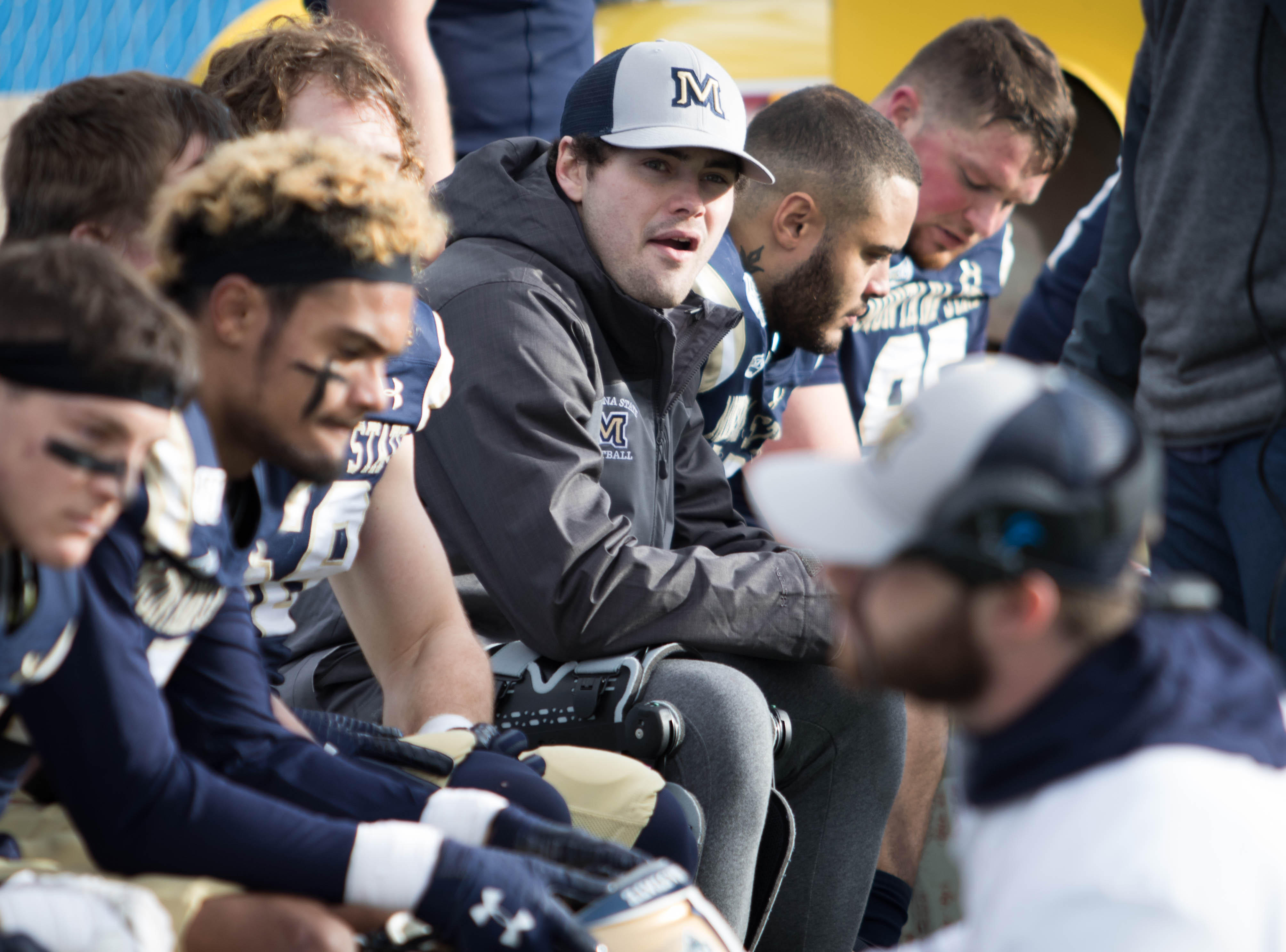
The Bobcats fought their way out of the corner with their backs pressed against the proverbial ropes for the second year in a row, proving that Choate’s hard-nosed, roughneck style was well suited for late season success. Andersen rolled up seven tackles and a pair of sacks in a 42-7 win over Southern Utah. He had seven tackles and a sack in a 45-14 win over Northern Colorado on an afternoon in Greeley he also threw a touchdown and rushed for another score.
The following weekend, Andersen made his third and final start as a two-way player in a game against UC Davis. He notched six tackles, two for a loss, while rushing seven times for 51 yards and a crucial score that lifted MSU to a 27-17 win over the defending Big Sky champions. The effort kept Montana State chugging toward the postseason.
Little did anyone know that evening in 2019 would be the last time Andersen would put on football pads until August of 2021. Andersen watched in street clothes from the sideline while his teammates, rather than wither on the vine in the absence of his incandescent talent, mounted a rally to remember and eviscerated rival Montana 48-14.
That emphatic victory, the largest margin for the ‘Cats over the Griz in more than 40 years, sparked a run that stretched all the way to the semifinals of the FCS playoffs.
Meanwhile, the future of the myth from Montana seemed for the first time to stand still.
No one but Paul Bunyan would ever tackle a job like that. To drive logs upstream is impossible, but if you think a little thing like an impossibility could stop him, you don’t know Paul Bunyan. He simply fed Babe a good big salt ration and drove him to the upper Mississippi to drink. Babe drank the river dry and sucked all the water upstream. The logs came up river faster than they went down.
The Montana State physicians told Choate the injury was a severe high ankle sprain that “would heal in time, it would not require surgery,” the former head coach said in June of 2020 almost five years to the day after Andersen had pledged his commitment to Choate and the ‘Cats.
Instead, the lower leg injury did not heal. Andersen explored the option of surgery.
By February, Andersen started seeing a specialist in Vail, Colorado. When he was on his way for surgery, the highway was suddenly closed due to an avalanche. Andersen and his mother never made it from Denver to Vail, instead turning around to return to Montana. The following month, the regular world stopped with the advent of the coronavirus pandemic. Elective surgeries took a months-long pause.
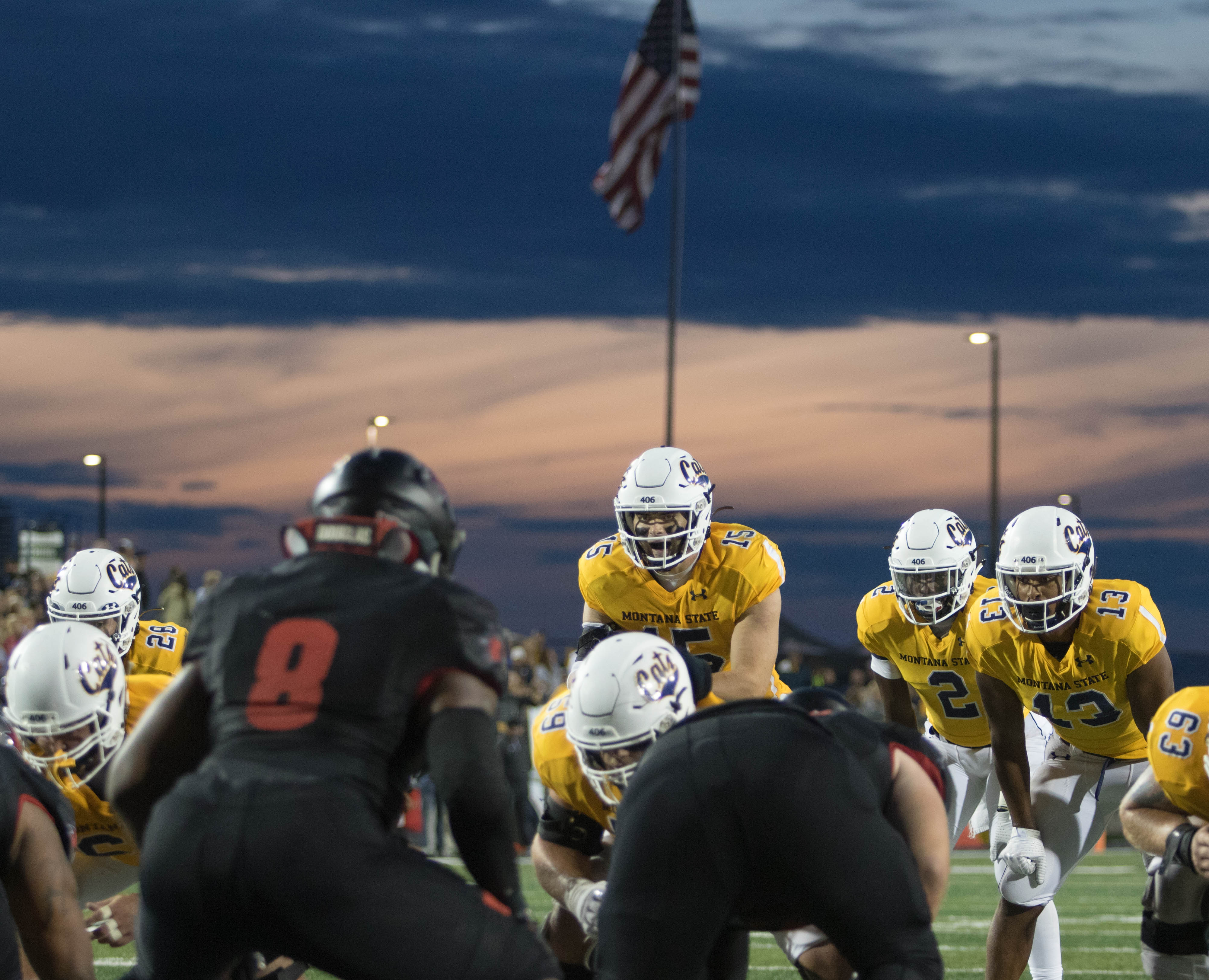
By late May of 2020, Andersen finally had the surgery. But the doctors told Choate that his thoroughbred would not be ready for full-go until late November or early December.
So in June, in customary Choate fashion, the coach buried the lead while making a profound statement. He hosted a 15-minute Zoom press conference to promote discussion of racial inequality in America following George Floyd’s brutal murder earlier that summer. Tucked into the discussion was Choate’s confirmation to the Montana media that the mythical Dillon product would take a medical redshirt during the upcoming 2020 season.
“I’m going to tell everyone on this call this: Troy Andersen should not be the headline,” an impassioned Choate stated that day. “I’m going to tell you this right now and I’m going to be honest with you, the thing that would piss me off is that tomorrow there’s something on the Bozeman Daily Chronicle and it says “Troy Andersen, blah blah blah” and then it says, ‘Oh by the way, let’s talk about this race issue.’
“Let’s keep the main thing the main thing. I’d write two stories.”
Choate went on to tell the whole story about Andersen nearly coming back for MSU’s 2019 FCS playoff semifinal against North Dakota State (a 49-14 loss in MSU’s first Final Four appearance since 1984) to the misdiagnoses to the avalanche.
“Literally, he and his mom are driving up from Denver to Vail and an avalanche closes the highway,” Choate said. “They turn around and come back to Bozeman. A few weeks later, we get him set up with a doctor in Minnesota who is a specialist in his issue. They tell him he needs surgery.
“Long story short, he was going to have a surgery that was going to keep him out, he might’ve missed some preseason stuff but because Covid-19, the surgery didn’t occur until (the third week of May.)
“The plan is for Troy to complete his eligibility in 2021.”
Oh how things can change in a calendar year.
WHEN a man gets the reputation in the woods of being a “good man” it refers only to physical prowess. Frequently he is challenged to fight by “good men” from other communities.
The myth of Montana could have left. He could have followed the trends and penned a homogeneous letter on Twitter, giving thanks to those who “blessed and honored” him. He could’ve broken hearts from Havre to Miles City, Kalispell to Billings with an all too common “with that being said”. With effort and exposure, Andersen could have transferred to literally any school in the country.
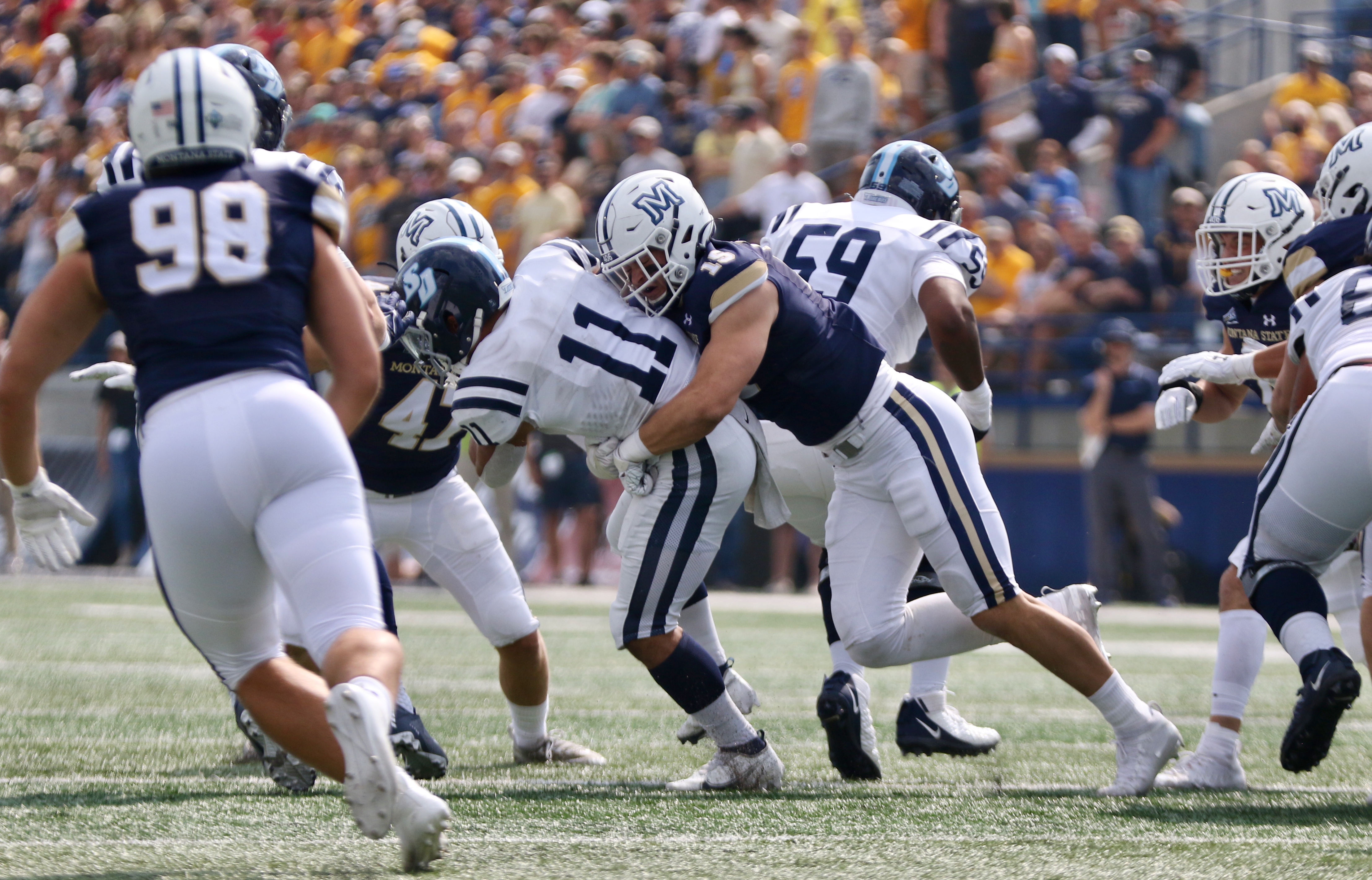
Instead, the modern day Paul Bunyan came ready to fight.
Coming off his surgery, the dominoes fell in rapid fashion. First, even though Andersen was slated to redshirt, he and his teammates were robbed of a season when the Big Sky Conference called off football in the fall of 2020.
Then he had to sit idle during fall ball that year, watching his teammates practice 15 times while he was relegated to rehab.
Choate then got restless, thrusting his name into the mix for the head coaching opening at Boise State. When a return to the place Choate first established himself as an elite FBS assistant (2006-2010) did not come to fruition, the specter of success on a grander scale than the Big Sky Conference had already been raised and loomed overhead.
Within weeks, the mercurial, charismatic Grizzly slayer was on the move, heading to the Lone Star State to serve as the co-defensive coordinator on Steve Sarkisian’s staff at Texas.
Andersen and his veteran collection of super-senior teammates were left to navigate still more uncertainty with an upcoming season filled with unrivaled expectations staring them right in the faces.
“All those guys who came in with the new staff, they went through a lot of lumps, man,” said Gregorak, who’s final season coordinating the Bobcat defense came in 2018 and who has not coached since, instead moving into an analyst role on the
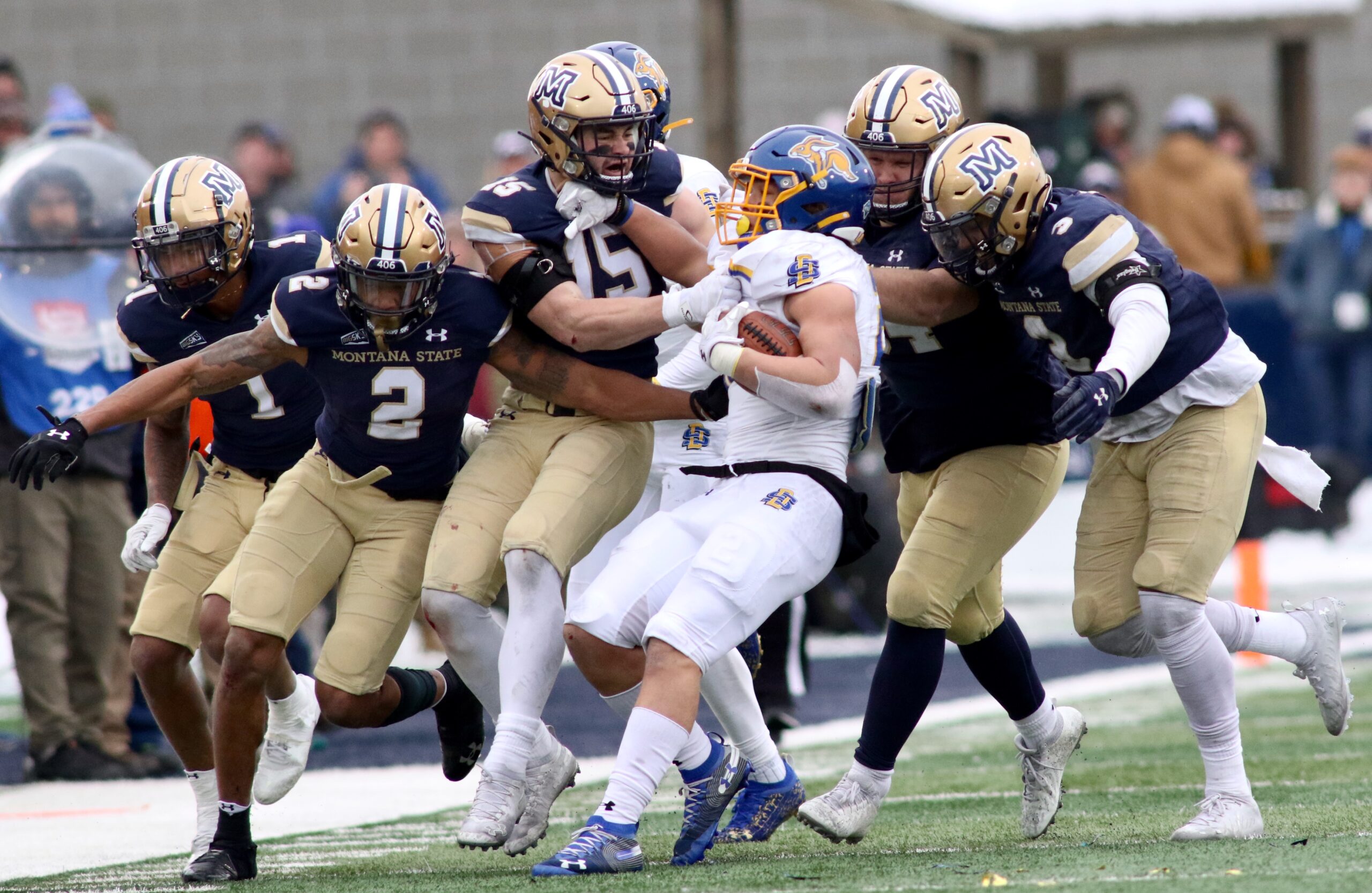
“The pandemic, that was tough. Coaching change, coming off the semis, tough. New coaching staff, tough. Injuries… it was not easy to get to the 2021 season. And Troy led the way.”
Most of his peers would’ve nauseatingly posted on social media about the dozens of contacts he received from coaches and schools coast to coast. And make no mistake — plenty of schools were in contact. But we will almost certainly never know who. And the kid from Beaverhead County wasn’t about to tell anyone.
Andersen only has 1,276 Twitter followers. His last tweet is a retweet of a post made by former Bobcat wide receiver Travis Jonsen. The post is a photo of the former All-Big Sky weapon with legendary quarterback Tom Brady after Tampa Bay won the Super Bowl in 2020.
Andersen also has a retweet of a story about his cousin, Codi Heuer, who pitches for the Chicago White Sox. He also re-upped a tweet of Dillon product Jace Fitzgerald, R.J.’s younger brother, committed to the ‘Cats in May of 2020, the latest Dillon product to keep the pipeline of Beavers to Bobcats strong.
Andersen’s only tweet that has anything to do with himself from the last five years came on April 20, 2020 when he sent a video message to Troy Ross, a young boy who has battled pulmonary capillaritis and garnered exposure on social media under the initiative #TroyStrong.
That’s all to say Andersen is not part of the “Blessed and honored to receive” crew that almost completely engulfs most of contemporary college sports. So, whoever might’ve called Andersen, he did not leverage such conversations for a greater public profile. Nor did he jump ship to the Power 5.
“Out of everybody that could’ve left or gone some place, it could’ve been him,” MSU All-American defensive end Daniel Hardy said. “The guy has unlimited potential. He’s an amazing football player and out of the years I’ve been here, I’ve seen this man do everything you can possibly ask him to. Carry the ball, throw the ball, whatever it is. The dude is an absolute animal. He deserves a statue on campus.”
And despite his quiet, introverted nature, Andersen rose to the occasion as a leader and became the tie that bound Montana State football in his final memorable season with the Bobcats.
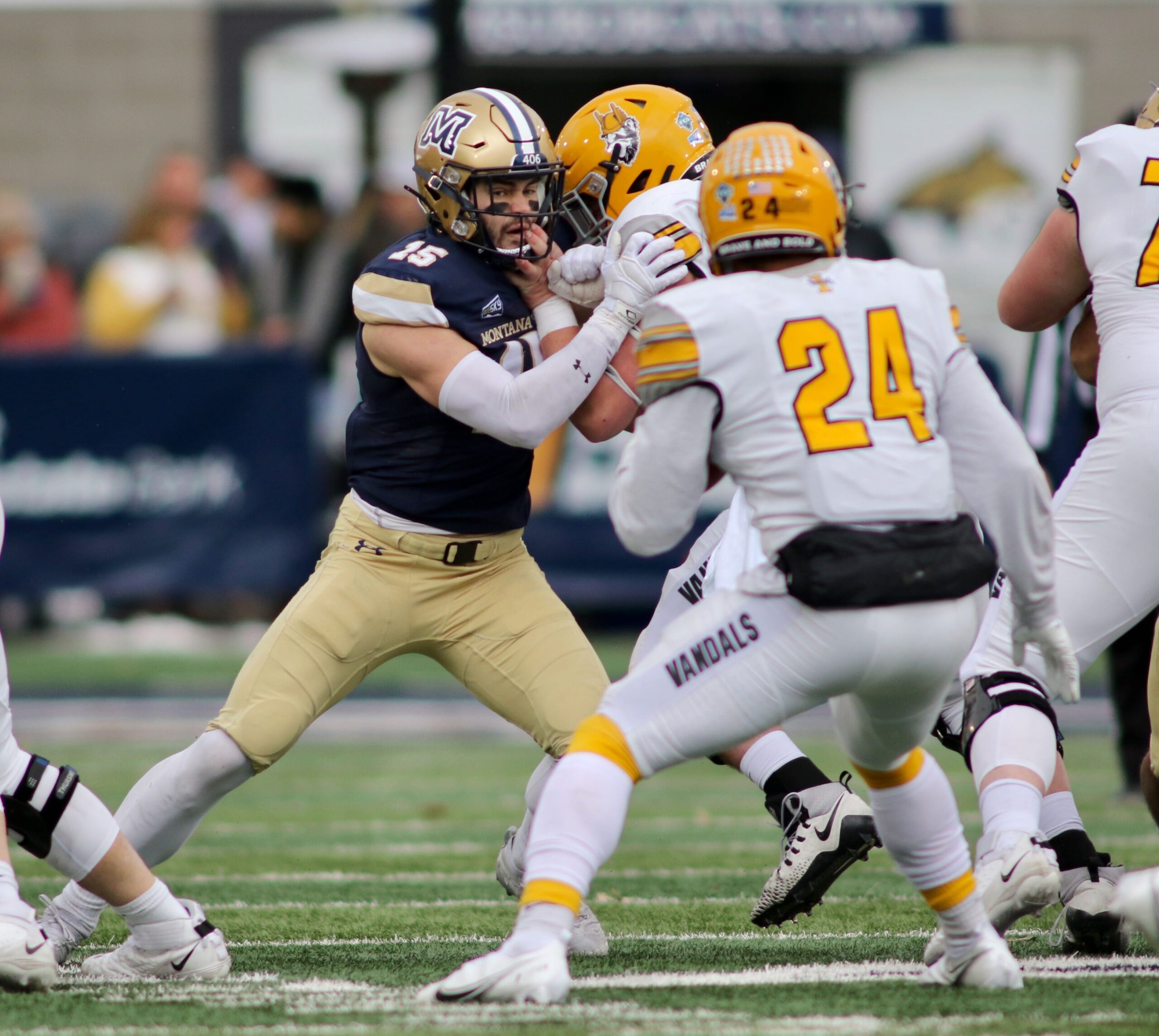
“I’ll tell you this: This season does not happen without Troy Andersen and I do not mean from his playing standpoint,” Choate said. “The leadership that he stepped forward and showed when there was some issues with the (coaching) transition is the untold story of this season.
“This season was about Troy going in and holding this thing together almost by himself. And he had to sacrifice to do it. I think that’s the real brilliance behind Troy Andersen. He went from being a guy who wouldn’t say boo to anybody, just let me play, to being a guy who was forced into this role — and quite honestly, partially by my decision — and said screw it, I’ll do it. And did. And kept that thing tight.”
Andersen’s simplistic mindset is a key to his success. It’s also a primary reason he stayed.
“It’s been crazy with Choate leaving and Covid but you take it one day at a time,’ Andersen said. “That’s an old football adage but that’s how I live my life. You spend time with your teammates and we knew we would be playing again and we knew we had a solid group of guys who would go make a run.”
Tight indeed. Montana State nearly sprung an upset in Laramie against a Wyoming team that won eight games the previous season to open 2021, ultimately falling 19-17 despite 11 tackles in Andersen’s middle linebacker debut.
MSU ripped off nine in a row after that thanks to a lights out defense led by Andersen terrorizing opponents with his insane closing speed, hyperactive play recognition and rapid ability to learn his fourth different position at an All-American level.
His first start at middle linebacker resulted in double-digit tackles, the first of nine total contests last season with 10 or more tackles.
His sideline to sideline speed is almost completely one of a kind at the FCS level, allowing him to pile up stops even if he still is learning how to engage at the point of attack or get off blocks. He has hardly been developed at his latest position, yet he played it better than anyone in the conference or the subdivision in his 15-game sample size.
But it’s Andersen’s ability in coverage, sometimes manning up slot receivers, other times roaming the middle of the field as a type of rover/safety with unheard of size and explosion has captivate the attention of NFL teams.
“He’s a once in a lifetime talent,” Freddie Banks, MSU’s then-defensive coordinator said in the fall of 2021 before moving on to Colorado State this off-season. “I probably won’t get to coach a guy like that again.
Those natural gifts and impressive mental acuity helped spearhead a Bobcat defense that put up historic numbers. MSU gave up 15 points per game on the way to 12 wins and an appearance in the national title game for the first time in 37 years.
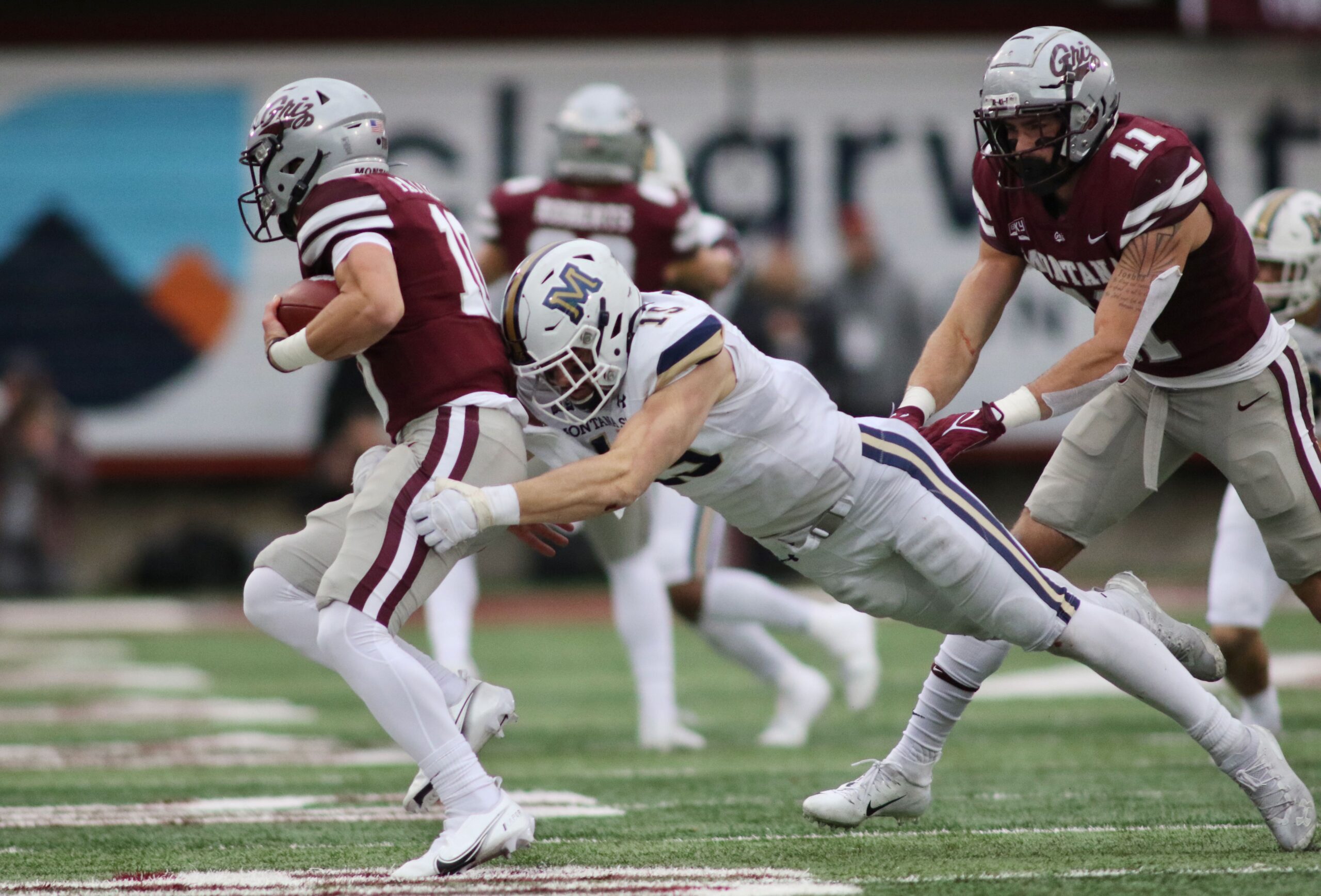
Andersen rolled up 147 tackles, 14 tackles for loss and two sacks. He snared a pair of interceptions, including one he returned for a touchdown in a home win over San Diego. He broke up seven more passes.
The achievements are numerous, piling up highlight reels and postseason accolades. Andersen earned Big Sky Defensive Player of the Year and FCS Defensive POY honors. He was the runner-up for the Buck Buchanan Award given to the top defensive player in the FCS.
“You see him close in on guys, they think they have the angle, then you have to be thinking again because he is going to be breathing down your neck before they know it and by the time they do, it’s going to be too late,” said Montana State associate athletic director Dan Davies, who has been part of the MSU radio broadcasts for most of the last 30 years.
As the Bobcats kept winning, Andersen’s lore continued to spread outside the borders of the Treasure State, beyond the reach of the Big Sky Conference.
As Montana State prepared for a quarterfinal matchup in the FCS playoffs with a second straight Final Four appearance on the line, Sam Houston head coach K.C. Keeler needed an explanation.
Keeler, the 2016 Eddie Robinson Award winner as the national coach of the year and a two-time FCS championship winner who had led his team to the FCS Final Four eight times since 2002 between stints at Delaware and Sam Houston, had questions.
“You have to explain this to me because I swear he played quarterback once upon a time,” Keeler asked Skyline Sports during a Zoom call in December of 2021.
When assured that Andersen did indeed play offense for two seasons full-time and three seasons overall, Keeler’s eyebrows raised.
“But I’m not surprised,” said the coach who led SHSU to more Division I wins in a calendar year (24) than any coach in college football history. “That dude is a ball player. A ball playing Jesse as one of my former assistants used to say.
“He just explodes off the film. I’m not sure I’ve seen a faster, more explosive linebacker at this level.”
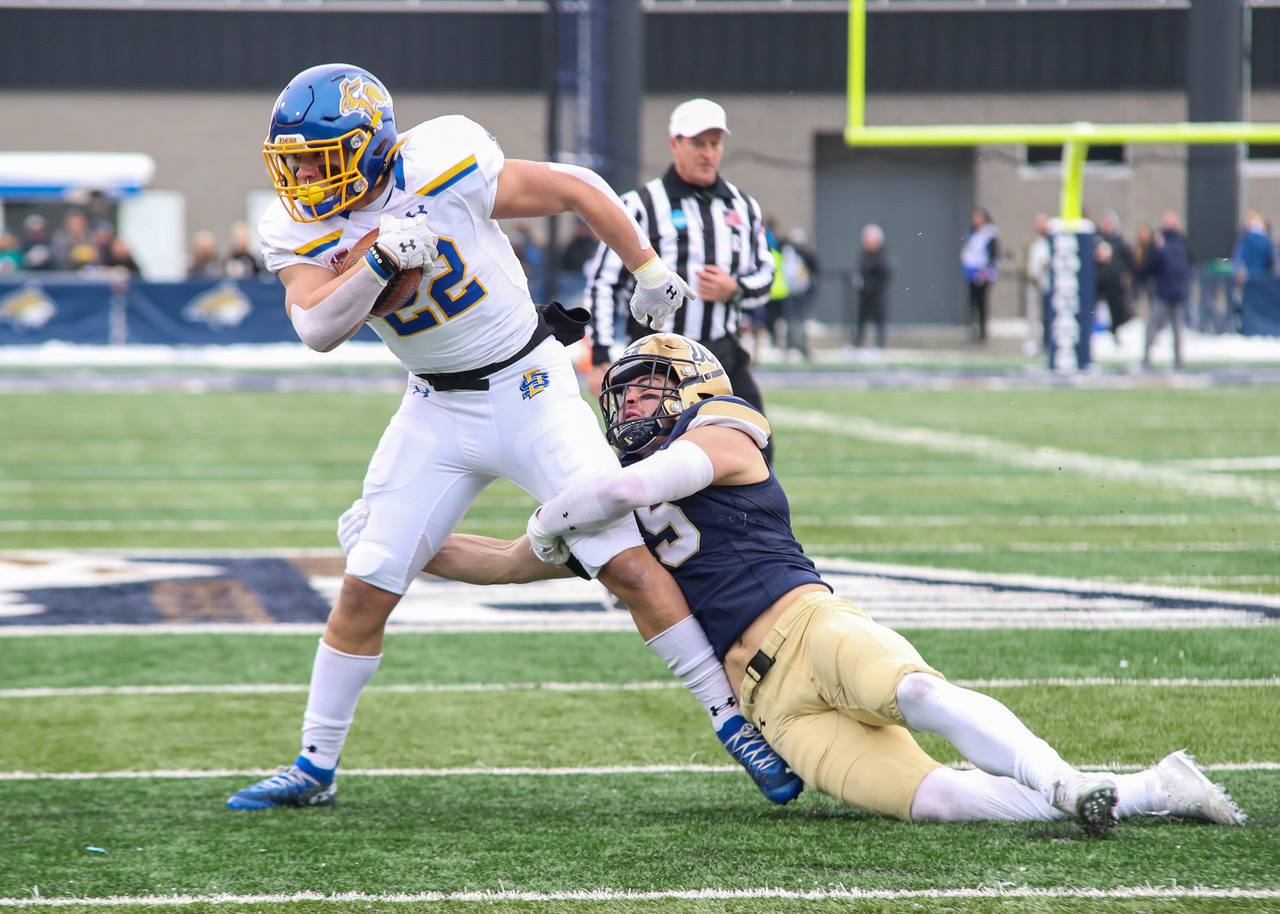
While diving for a sideline tackle, Andersen dinged his previously injured shoulder in Montana State’s playoff game at Huntsville, a place the Bobcat program experienced an embarrassing loss in the same round of the postseason 10 years earlier. But Andersen also made two touchdown-saving plays to help Montana State’s sprint out of the gates to a 28-0 lead hold.
That night in December of 2021, MSU posted a historic 42-19 win over Keeler’s Bearkats. The victory over the 2021 FCS spring national champions marked Montana State’s first road Division I-AA/FCS playoff win since the subdivision formed in 1978. And it marked the first time in 34 postseason home games Sam Houston State lost a playoff game on its home field in Huntsville, Texas.
As if the physical prowess was not impressive enough, Andersen is also one of the top students of any college football player in all of Division I.
Before Montana State was set to travel to Cheney, Washington take on rival Eastern Washington in a showdown of two of the best teams in the country — a game with playoff and Big Sky title ramifications — Costello, who has been MSU’s athletic director since 2016, gave an announcement in front of the team with Vigen and the rest of the Bobcats looking on.
“The William H. Campbell Trophy is the Academic Heisman, the best scholar-athlete over all divisions of football,” Costello said. “And are very honored to have someone here in this group.”
“The only finalist out of the FCS — Troy Andersen,” Vigen finished for Costello. “Troy could rest on his ability and he would just be fine. But an award like this is about taking your abilities to the next level, whether that’s on the field, in the classroom, in the community.
As the group of Bobcats collectively hooted and hollered, then started chanting “speech, speech”, Andersen, who was in street clothes like most late-week practices this season, simply said, “Let’s beat Eastern Washington.”
Troy Andersen, in a nutshell.
“Guys like Troy don’t come around very often and we are so fortunate to have him on our campus” said Davies, a Chinook, Montana native who was a walk-on on MSU’s 1976 national title team and an assistant coach on Montana State’s 1984 national title team. “He leads in so many ways, starting with academics. Then you have him winning MVPs on both sides of the ball, playing every position, leading this team through one of the weirdest times we’ve experienced as humans.
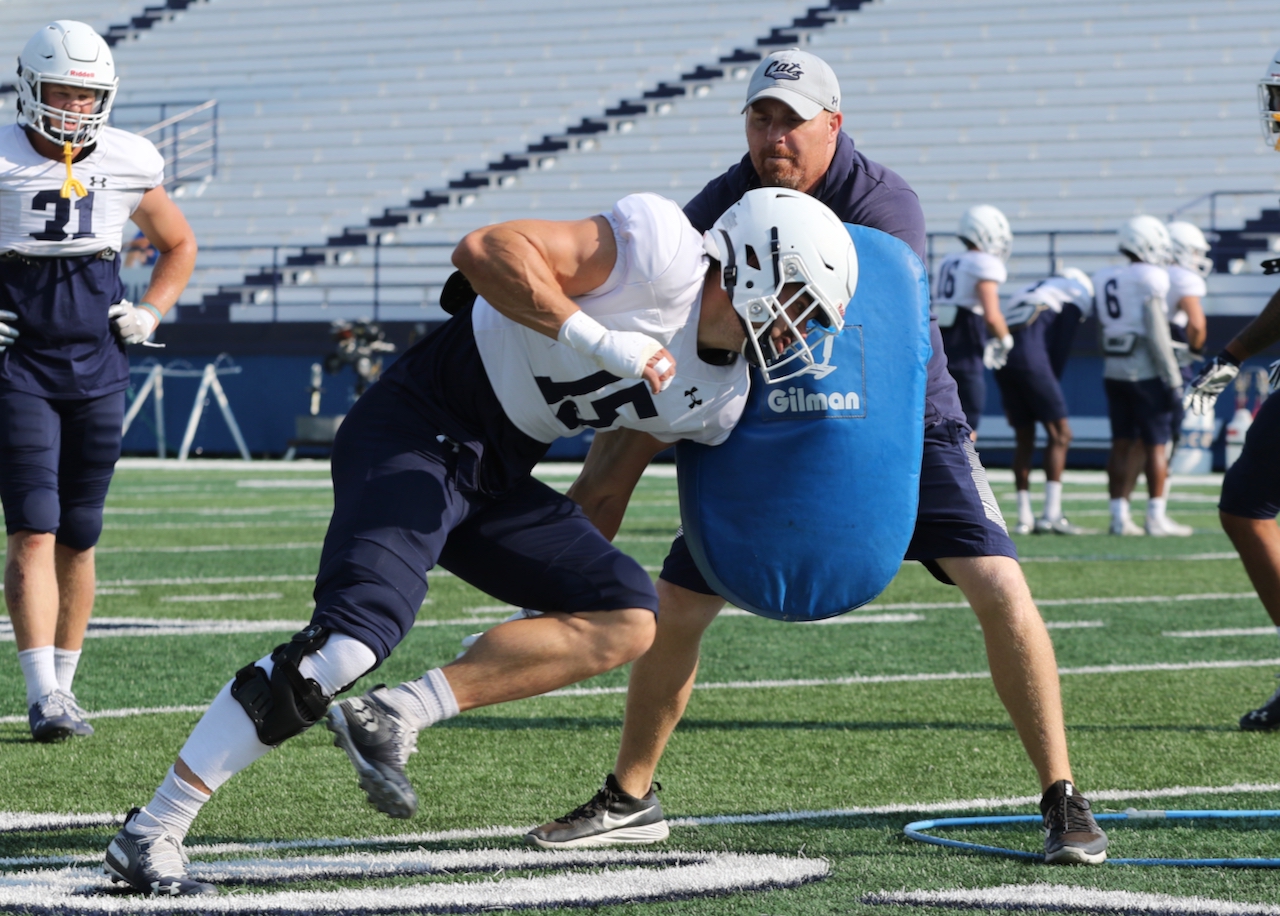
“It’s a story that I’m not sure will ever be written again, maybe ever. We have witnessed history.”
Andersen graduated from Montana State University with a near-perfect grade-point average in agricultural business after switching from engineering. He has always been a high achiever in the classroom, earning a perfect GPA and valedictorian honors in high school as well.
“My parents have always told me to do my best in school and I’ve just tried to do my best at everything, I guess,” Andersen said. “Not slack off in school, in football, take everything you do seriously and try to do your best.”
“It is kind of weird where people try at one thing and don’t try in other parts of their life, it doesn’t make much sense. I try to schedule time for everything and make sure I get everything done and do my best.”
Throughout the last several years, many wondered just how long Andersen would pursue his football dreams. Those who know him best say he is just as content riding a horse, hunting in the mountains or fishing Montana’s pristine rivers as he is living in the spotlight provided by his absurd athletic achievements.
“He embraces Bozeman as a second home. All the people he’s been in contact with, Dillon is his true home but he has just as much pride in representing the people of Bozeman, Montana State University and the state of Montana,” Nordahl said. “He could be pushing calves into their family place next weekend out back, getting kicked by calves, it doesn’t matter. He knows where he comes from and loves representing Montana any way he can.”
Andersen’s achievements athletically and academically means he won’t have to search very hard for work if his NFL dreams don’t work out.
“I grew up on a ranch and I think eventually I want to go back there but I think I want to do something else before that,” Andersen said. “I really don’t know what that is yet. I’ll figure it out.”
It’s unlikely that figuring a professional career out will be all that complicated, particularly now that the myth of Montana has hit the national hype cycle. Outlets from coast to coast hope to tell the story of the anomalous player from next to the middle of nowhere, catching up to what so many around the Last Best Place have known for quite some time.
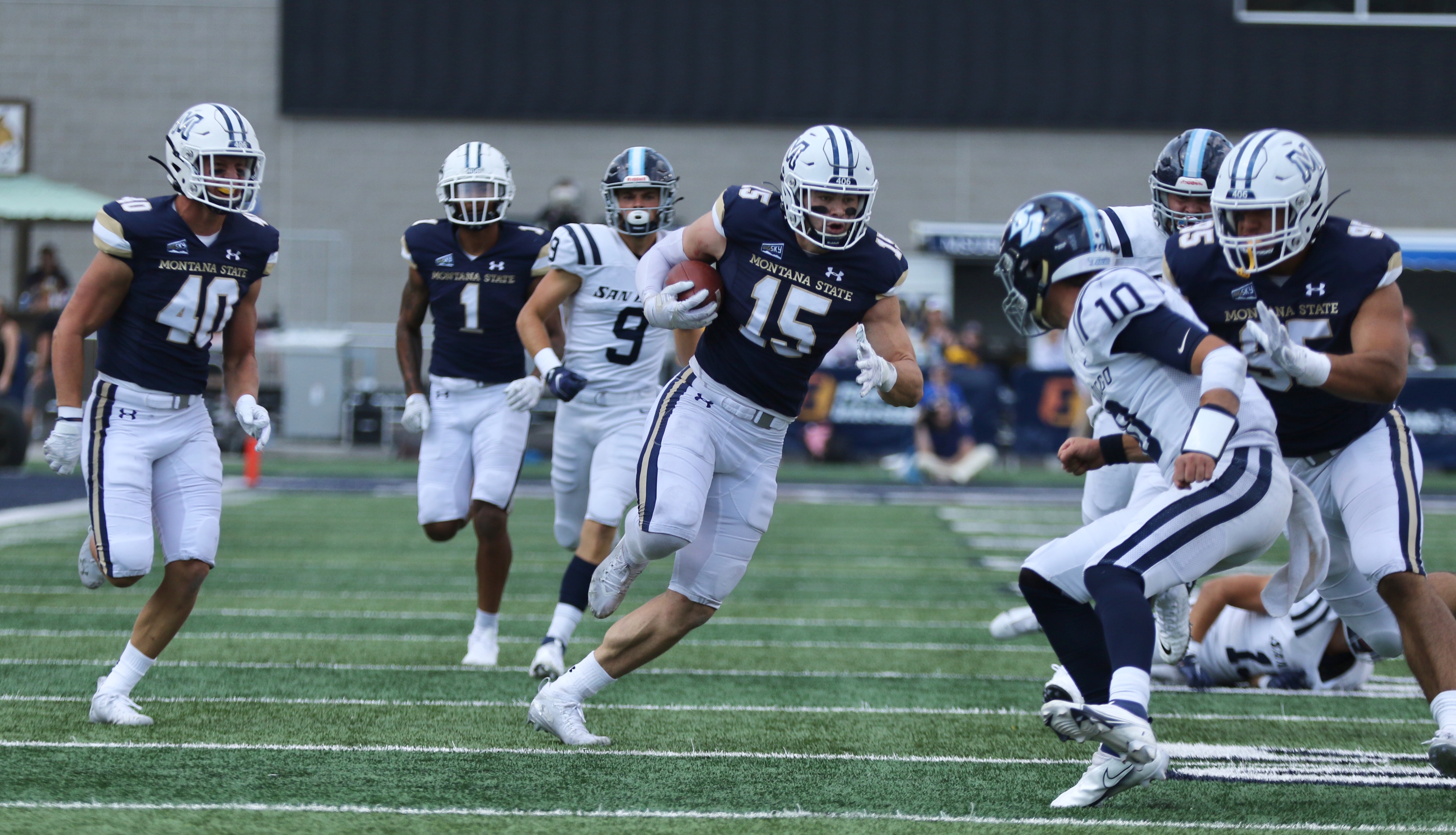
Andersen has never felt the urge to promote himself. He’s never felt like some exceptionally gifted prodigy nor that he’s from some mysterious place. He doesn’t live on Twitter and he doesn’t play for the spotlight, the stardom or the attention. He is simply playing football, mastering an education and chasing his dreams.
“Every time you take the field, the Senior Bowl, the NFL Combine, it’s just football. It’s still just football,” Andersen said. “You play at Montana State and I think we play good football here and then you go down there and it’s like, I guess we do. We have really good players here. So many guys on our team can fit in anywhere in the country.”
One of the only remaining questions about Andersen’s professional football future is what position he might play. While at NDSU and then Wyoming, Vigen saw his fair share of NFL talent. He helped develop a quartet of quarterbacks who got drafted, including former Top 10 picks Carson Wentz, who Vigen coached in Fargo, and Wyoming’s Josh Allen. Vigen also had an up close and personal view to players like defensive end Kyle Emmanuel and linebacker Jabril Cox at NDSU along with linebackers Logan Wilson and Chad Muma at Wyoming.
“Troy would be right up there with the guys I’ve been around and when you quantify his whole career and what he’s done, that puts him on a whole different level,” Vigen said in December of 2021. “I was not here for the quarterback and running back days but I think what goes unseen is that he’s out there on special teams a whole bunch too. There’s a trust factor that a player of his caliber brings to special teams but there’s a complete buy-in on his part too. I think any opportunity he has to go out and help us win a football game, he wants to.
“He’s an extremely talented individual. He has been blessed with great size, great speed and on top of that, he’s very intelligent. He’s an amazing competitor. And on top of all of that, he’s probably our best leader. All those things, combined with the fact he played a brand new position again this year, translate to the next level.”
Choate has never shied away from how dangerous Andersen is in space, whether the speedster is chasing down opponents or running away from them. He could see a role for Andersen in the NFL that many might not have thought of – a “stretch nightmare tight end who is a match up problem because of his speed and power,” Choate said, the imagination lilting in his voice.
“There’s a lot of options down the road,” he said.
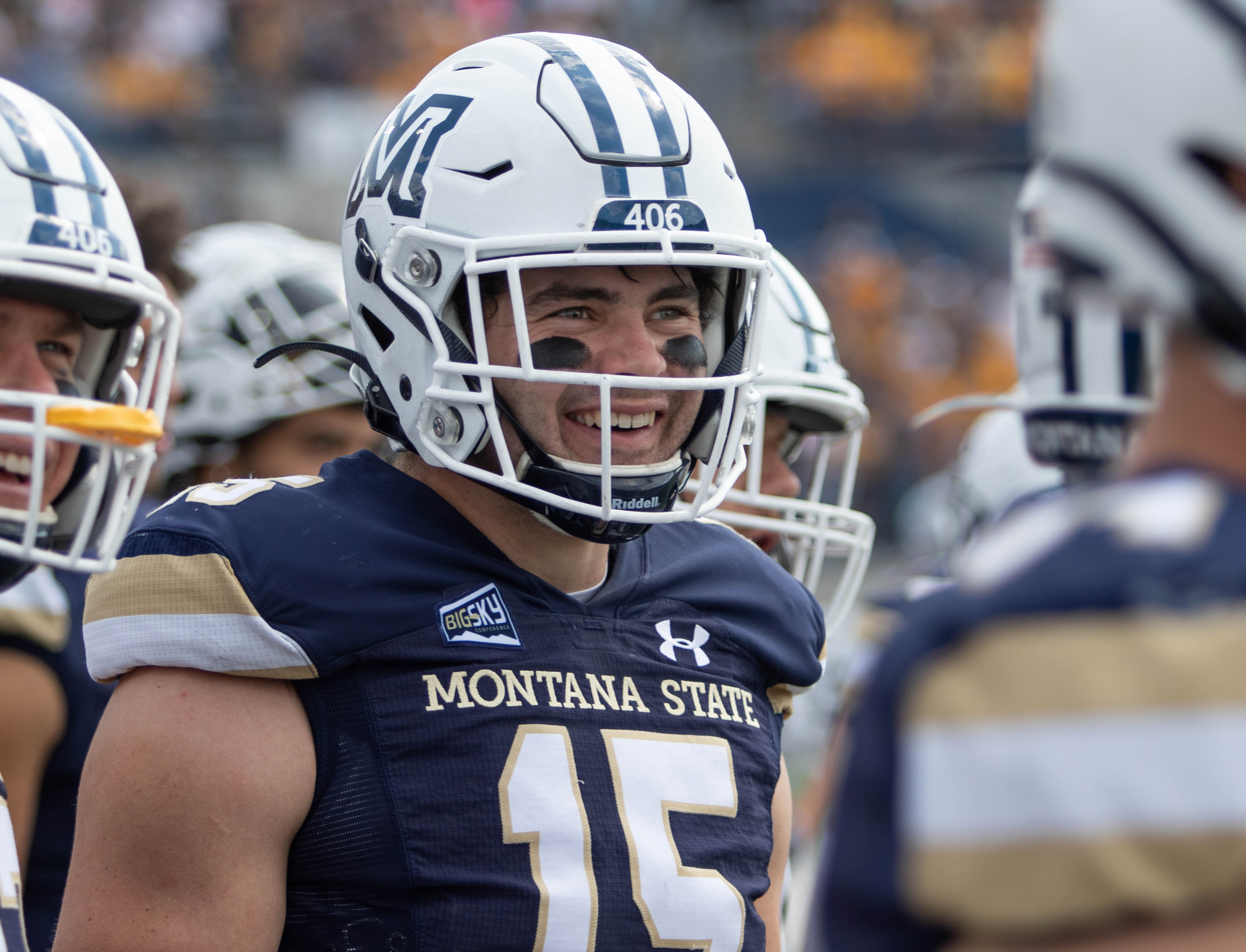
Down the road has always been the way Andersen’s future has been described. His potential will be realized some time in the future, when he gets the chance to show the world his talents, so many Montanans have thought.
The moment is now here. The NFL Draft is this weekend in Las Vegas.
The myth of Montana does not see himself in the worshiping light that he’s attracted over the last five years. The myth is no longer folklore. Troy Andersen has cemented himself among the legends of Montana State football. Most believe he is the greatest Bobcat of all time.
The next chapters will simply reveal the heights his greatness might reach once he lets his talents shine for the rest of the world to see.
And if his effusive, unwavering domination of his competition reaches a crossroads once he reaches football’s highest level, he has already left behind a legend beyond compare in the modern history of the Treasure State.
“The lore, the myth of Troy Andersen is complete,” Gregorak said. “I think Troy Andersen is the best football player to ever play at Montana State. I think that would be tough to deny. He’s the best all-around football player to ever play.”
Photos by Brooks Nuanez – Skyline Sports; or noted. All Rights Reserved.
